
Filler words are found in all spoken languages, and they’re an inseparable part of daily conversations. They provide us with the space we need to think before speaking or responding to someone. We also use fillers as a colloquial means to say something more succinctly; at times, a single filler word can express more about how we’re feeling than a lengthy dialogue could.
In this article, you’ll learn everything you need to know about filler words in Hindi and how they’re used. Once you’ve mastered this key element of conversation, your Hindi skills will go from “so-so” to “near-native”!
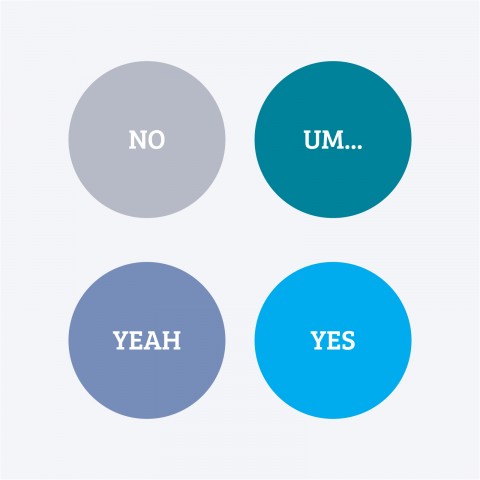
 Table of Contents
Table of Contents
- What are filler words and why are they so popular?
- Popular Fillers in the Hindi Language
- Pros and Cons of Filler Words
- Let’s Crush it with HindiPod101.com
1. What are filler words and why are they so popular?
True to their name, filler words give us an easy way out by “filling” our pauses in speech whenever we’re looking for a specific word or deciding how to phrase something. Hindi filler words are local expressions abundantly used by natives in their day-to-day lives.
They’re so popular because, more often than not, they give us the crucial time we need to think about what we want to say. In addition, filler words make it easy to express an array of emotions: surprise, shock, pain, pleasure, boredom, disappointment, and the list goes on. Using filler words can also help us remain courteous and polite to the other person.
You see, filler words in Hindi are nothing short of life-savers. It goes without saying that it’s hard to imagine life without them, especially for Hindi-speaking natives.
2. Popular Fillers in the Hindi Language
In this section, we’ll be covering the most common Hindi conversation filler words along with explanations and examples of how to use them.
Quick Note: Most of the examples below are dialogues between person A and person B. If “A” and “B” are not mentioned, this means the example is only a sentence spoken by one person.
#1 अच्छा (acchaa) = “Really!” or “Okay”
One of the most common Hindi filler words is अच्छा (acchaa). It’s a multipurpose word that serves beautifully in different situations. For instance, it could represent affirmation, surprise, or even mockery, depending on the context of the conversation.
This word allows the speaker to pause and gain some time to gather their thoughts. Here are two different situations where it can be used:
- अच्छा! (acchaa!) = “Really!”
As you can see, the word here denotes an exclamation of surprise!
| A. हेमा ने नया मकान ले लिया है। (hemaa Ne Nayaa makaaN Le Liyaa hai.) B. अच्छा! कब? (acchaa! kab?) |
| A. “Hema has bought a new house. “B. “Really! When?” |
- अच्छा (acchaa) = “Okay”
This is the most basic expression to say “yes” or “okay,” and it can be used to let the other person know that you’ve heard them.
| A. मुझे वो फ़ाइल मिल गई है। (mujhe vo faaiL miL gayii hai.) B. अच्छा। (acchaa.) |
| A. “I have got that file. “B. “Okay.” |

#2 हम्म (hmm) = “Hmm”
In situations where you’re immersed in a conversation and just want to nod along, हम्म (hmm) is the perfect filler in Hindi to use. Just like our first example, this phrase gives you the chance to take some time before responding.
| A. पूरा अख़बार चुनाव की ख़बरों से भरा है। (puuraa akhabaar cuNaav kii khabaron Se bharaa hai.) B. हम्म। तुमने सही कहा। (hmm. TumaNe Sahii kahaa.) |
| A. “The whole newspaper is filled with election news. “B. “Hmm, you’re right.” |
#3 मतलब (maTaLab) = “I mean”
When dealing with delicate topics, it’s wise to be tender and use soft words. One phrase you could use is मतलब (maTaLab), which is similar to “I mean” in English.
| भ्रष्टाचार कितना आम हो गया है। मतलब, लोग अब मुंह खोलकर घूस मांगते हैं। (bhrastaacaar kiTaNaa aam ho gayaa hai. maTaLab, Log ab munh khoLakar ghuuS maangaTe hain.) |
| “Corruption is so common nowadays. I mean, people openly ask for bribes.” |
#4 चलो, ठीक है (caLo, thiik hai) = “Alright”
Have you ever been in a situation where you tried to calm someone down or had to step back to give everyone time to cool off? Then you know just how tense things can get and understand the importance of a well-placed word or expression.
The exact phrase you’re looking for is चलो, ठीक है (caLo, thiik hai), which means “alright.” It fulfills the purpose of speaking more indirectly in order to encourage politeness in tense circumstances.
| A. मेरा मूड बहुत ख़राब है। मुझे अभी अकेला छोड़ दो। (meraa muud bahuT kharaab hai. Mujhe abhii akeLaa chod Do.) B. चलो, ठीक है। जब बेहतर महसूस करो, तो मुझे फ़ोन कर लेना। (caLo, thiik hai. jab behaTar mahaSuuS karo, To mujhe foN kar LeNaa.) |
| A. “I am really upset. Please, leave me alone. “B. “Alright. Call me when you feel better.” |

You know, that’s a planet.
#5 लगता है जैसे (LagaTaa hai jaiSe) = “It feels like”
When our instincts are at their best, we feel things that can’t be explained logically. You just feel it in your heart and in your bones. To express such emotions, the Hindi phrase लगता है जैसे (LagaTaa hai jaiSe), meaning “it feels like,” comes in handy. Please keep in mind that this phrase can easily be used in mundane or lighthearted situations as well.
| पिंकी अजीब सा बर्ताव कर रही है। लगता है जैसे वो कुछ छुपा रही है। (pinkii ajiib Saa barTaav kar rahii hai. LagaTaa hai jaiSe vo kuch chupaa rahii hai.) |
| “Pinki is behaving so weird. It feels like she is hiding something.” |

Ah! I have an idea.
#6 ठीक है? (thiik hai) = “Okay?” or “Got it?” or “Deal?”
Sometimes it’s necessary to emphasize what you’re saying in order to be sure that you and the other person are on the same page. In such moments, the Hindi phrase ठीक है? (thiik hai) does the job well.
| ये होमवर्क कल तक जमा करना है। ठीक है? किसी को कुछ पूछना है तो अभी पूछ लो। (ye homavark kaL Tak jamaa karaNaa hai. thiik hai? kiSii ko kuch puuchaNaa hai To abhii puuch Lo.) |
| “You have to submit this homework by tomorrow. Okay? If anybody has any questions, you can ask me now.” |
#7 पता है (paTaa hai) = “You know”
We humans are storytellers. Most of us are quite good at adding spice to our dialogue or provoking curiosity in even the dullest conversation. Are you looking to translate those skills into Hindi? Then just use the phrase पता है (paTaa hai), meaning “you know,” and you’re good to go!
| पता है, हमारे शहर में क़रीब पचास अस्पताल हैं। जिनमें से केवल बारह ही सरकारी हैं। (paTaa hai, hamaare sahar men qariib pacaaS aSpaTaaL hain. jiNmen Se kevaL baarah hii Sarkaarii hain.) |
| “You know, there are around fifty hospitals in this city. And only twelve of them are public.” |
#8 सुनो (SuNo) = “Hey”
Want to grab attention in the blink of an eye? Then try uttering the word सुनो (SuNo). This is a popular Hindi filler word similar in function to the English word “hey.”
| सुनो, कल मूवी देखने चलें क्या! (SuNo, kaL muuvii DekhaNe caLen kyaa!) |
| “Hey, let’s go and watch a movie tomorrow!” |
#9 जानते हो / जानती हो (jaaNaTe ho / jaaNaTii ho) = “You know”
Another common phrase for “you know” is जानते हो / जानती हो (jaaNaTe ho / jaaNaTii ho). You can never go wrong with this phrase when trying to start a conversation with someone.
| जानते हो, बचपन में मुझे शतरंज खेलना बहुत पसंद था। (jaaNaTe ho, bacapaN men mujhe saTaranj kheLaNaa bahuT paSanD THaa.) |
| “You know, when I was a kid, I loved playing chess.” |

Well, I don’t know. I’m confused.
#10 पता नहीं (paTaa Nahiin) = “I don’t know”
When confused, doubtful, or even hopeless about something, natives often use the Hindi phrase पता नहीं (paTaa Nahiin) to vent. Here’s how to use this Hindi filler phrase:
| A. नौकरी बदलने के बारे में क्या सोचा? (Naukarii baDaLaNe ke baare men kyaa Socaa?) B. पता नहीं। मैं फ़ैसला नहीं कर पा रही। (paTaa Nahiin. main faiSaLaa Nahiin kar paa rahii.) |
| A. “What did you decide about the job change? “B. “I don’t know. I am not able to make up my mind.” |
#11 समझ नहीं आता (Samajh Nahiin aaTaa) = “I don’t get it”
Feeling helpless and don’t know how to express it in Hindi? Your safest option is to say समझ नहीं आता (Samajh Nahiin aaTaa). It’s popularly used in personal or casual conversations.
| समझ नहीं आता, ये लोग बार-बार वही ग़लती कैसे कर सकते हैं। (Samajh Nahiin aaTaa, ye Log baar-baar vahii gaLaTii kaiSe kar SakaTe hain.) |
| “I don’t get it, how can they make the same mistake again and again?” |
#12 क्या? (kyaa?) = “What?”
Life is never without surprises. We might hear news that’s shocking, stimulating, surprising, or of a greater magnitude than we can even imagine. In such cases, one of the most common Hindi filler words used by natives is क्या? (kyaa), meaning “What?”
Please note that, in this context, the meaning of क्या? (kyaa?) = “What?” is not literal. We’re not actually asking a question, but rather expressing genuine astonishment. Take a look at the example below to better understand this.
| A. गीता और सुनील ने शादी कर ली है। (giiTaa aur SuNiiL Ne saaDii kar Lii hai.) B. क्या?! तुम्हें कैसे पता चला? (kyaa?! Tumhen kaiSe paTaa caLaa?) |
| A. “Geeta and Sunil got married. “B. “What? How did you come to know?” |
#13 फिर? (phir?) = “Now what?”
This is another must-know phrase for when you need to pause and gather your thoughts before responding.
| A. मेरी फ्लाइट छूट गई। (merii fLaait chuut gayii.) B. फिर? अब क्या करोगे? (phir? ab kyaa karoge?) |
| A. “I missed my flight. “B. “Now what? What will you do now?” |
#14 हैं?! (hain?!) = “What?”
In this context, हैं?! (hain?!) is used to ask a rhetorical question. You already know the answer or the situation, but end up saying “what” out of surprise or disbelief.
| A. क्लास में सिर्फ़ दस बच्चे पास हुए हैं। (kLaaS men Sirf DaS bacce paaS hue hain.) B. हैं?! ये कैसे हो सकता है? (hain? ye kaiSe ho SakTaa hai?) |
| A. “Only ten students have passed the class. “B. “What? That’s impossible!” |

What! Really? I can’t be that cute!
#15 देखते हैं (DekhaTe hain) = “Let’s see”
There are two situations where the phrase देखते हैं (DekhaTe hain) could be aptly used:
1) When you’ve already made up your mind about something, but attempt to be polite by saying “let’s see” when you’re asked about it
2) When you genuinely don’t know what will happen
| A. आज के मैच में इंडिया की टीम काफ़ी अच्छा खेल रही है। (aaj ke maic men iNdiyaa kii tiim kaafii acchaa kheL rahii hai.) B. देखते हैं, आख़िर में किसकी जीत होती है। (DekhaTe hain, aakhir men kiSakii jiiT hoTii hai.) |
| A. “India is playing so well in today’s match. “B. “Let’s see who wins in the end.” |
#16 अरे (are) = “Oh!”
The one bankable Hindi filler word that native speakers use to express regret, pain, surprise, or even irritation is अरे (are), meaning “Oh!”
| अरे! मैं फिर उसका जन्मदिन भूल गई। (are! main phir uSakaa jaNmaDiN bhuuL gayii.) |
| “Oh! I forgot her birthday again.” |
#17 उफ़ (uf) = “Ugh”
| उफ़! बहुत गर्मी है। (uf, bahuT garmii hai.) |
| “Ugh! It’s so hot.” |
#18 ओह (oh) = “Oh!”
| ओह! इस बिल्ली को तो चोट लग गई है। (oh! iS biLLii ko To cot Lag gayii hai.) |
| “Oh! This cat is badly hurt.” |

Oh no! It’s impossible.
3. Pros and Cons of Filler Words
So, you’ve now seen the most common fillers in Hindi and know how to use them well. But before you start employing them in your conversations, you should be aware of the pros and cons.
On the one hand, filler words can help you sound more like a native speaker and break the ice with locals. They can also save you from embarrassment in critical situations. Hindi filler words are a wonderful tool to use when your brain needs a quick breath, when you feel awkward, or when you find yourself highly surprised by something. Using them well allows you to be delicate and to avoid scaring or offending the other person.
On the other hand, we would advise you to avoid using them in formal situations. If you’re in an interview, discussing a business plan, or participating in any kind of formal/public speech, using filler words is a no-no. Why, you ask? Well, filler words reflect low confidence. They project you as a person with a lack of clarity in his or her thoughts.
Here’s a tip to help you avoid falling into the trap of filler words:
Whenever you stumble or feel blank, use powerful phrases such as “another vital point is,” “let’s move on to,” or “the next thing I wanted to discuss is.”
4. Let’s Crush it with HindiPod101.com
Did you enjoy reading this article about Hindi filler words? Which phrase do you relate to the most, and why? Is there any other phrase we didn’t cover? Let us know in the comments below.
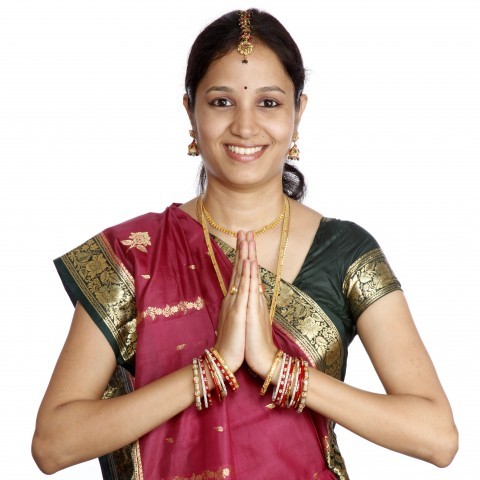
Learn Better at HindiPod101.com
Don’t stop yet, because there’s so much more for you to explore with us at HindiPod101.com.
Look up any new words you come across and find out their meaning in our free online dictionary. For a more comprehensive study session, we’ve also created a number of exciting lesson materials and a sound database to help you expand your Hindi vocab.
We offer plenty of language resources on our website as well as an easy-to-download mobile app to keep you hooked! So, what are you waiting for? Sign up at HindiPod101.com and say yes to Hindi learning with fun. With enough determination, you’ll be speaking Hindi like a native in no time!

30+ Ways to Say “I Love You,” in Hindi

Expressing your love or romantic feelings for someone is a delicate matter. You want to make sure you’re using the right words at the right time, because even the most romantic phrases can fall flat if used carelessly or in the wrong context. This can be hard enough to do in your own language, let alone in a foreign language like Hindi!
In this article, we’ll provide you with several words and phrases you can use to say “I love you,” in Hindi. You’ll soon be prepared for all of your future romantic endeavors in India and beyond.
 Table of Contents
Table of Contents
- Why Study Love Phrases in Hindi?
- Must-know Cultural Tips
- Pick-Up Lines to Confess Your Affection
- Fall in Deeper: “I Love You,” and More
- Hear the Wedding Bells?
- Endearment Terms
- Must-know Love Quotes
- Find Your Path with HindiPod101.com
1. Why Study Love Phrases in Hindi?
Being in love with someone from a different country/culture is such a phenomenal experience. If you’re attracted to someone who happens to be a native Hindi speaker, confessing your feelings or asking them out in Hindi may sweep him or her off their feet and melt their heart! After all, what could be more romantic than learning the mother tongue of one’s beloved?
In addition, you’ll find that the concept of love plays a significant role in the Hindi language. There are numerous words for “love” in Hindi, with the most common ones being:
- प्यार (pyaar)
- इश्क़ (isq)
- मोहब्बत (mohabbaT)
- प्रेम (prem)
And there’s more where those came from!

Confessing your love in Hindi
2. Must-know Cultural Tips
Human beings have come a long way to be where we are today. And yet, it’s worth remembering that cultures are a bit slow to change. For instance, while Indian culture has grown much more forward over the last two decades, there are still a few things that have remained unchanged.
Women are still a bit shy when it comes to expressing affection or responding to romantic gestures. It’s generally expected for men to take the first step in this regard, whether it be asking a woman on a date, proposing marriage, or saying “I love you.”
Also take note that kissing or hugging in public is strictly off-limits in India. Ideally, couples should limit their public displays of affection to holding hands or placing their hand on the other’s shoulder. For more details, check out our blog post on the basic do’s and don’ts in India.
When given compliments, Indians often smile and blush; this is simply a nonverbal way of happily responding to the compliment. Some may even reply with a confident “thank you” and offer a big, broad smile.
Now that you have a fair idea of the Indian culture and customs surrounding romance, let’s jump to the section that you’ve long been waiting for: our list of the most common love words and phrases in Hindi!
3. Pick-Up Lines to Confess Your Affection
Friendship is the foundation of every solid relationship. If you play your cards right, that relationship can slowly evolve into a romantic one.
We all go through the initial phase of liking someone and feeling attracted toward them, but it can be so hard to figure out the right words to express our interest. The good news is that, with these subtle love expressions in Hindi, confessing your love to a native speaker will be a piece of cake for you. 🙂

Hindi phrases to make your date unforgettable
Call it old-fashioned, but in Indian culture, the basic Hindi love phrases explained below are typically used by men rather than women. But of course, we all know that exceptions are everywhere!
| 1 – आप बहुत सुंदर हैं। (aap bahuT SuNDar hain.) | “You are so beautiful.” |
| This meaningful yet subtle phrase never goes out of style and it always works like a charm. It would be most appropriate to use this phrase when meeting your crush at a party or another special occasion. Be careful to use the phrase only when you know that the other person likes you, too. Otherwise, you might freak them out! | |
| 2 – तुम बहुत प्यारी हो। (Tum bahuT pyaarii ho.) | “You are so cute.” |
| This one’s a magic phrase, offering a healthy dose of general friendliness combined with a romantic tone. Full of care and love, the innocence contained within the phrase speaks for itself. If you really mean it, then say it to the person you like and watch the magic happen. | |
| 3 – क्या आप मेरे साथ बाहर / रात के खाने पर चलेंगी? (kyaa aap mere SaaTH baahar / raaT ke khaaNe par caLengi?) | “Would you like to go out/have dinner with me?” |
| A simple, safe way to ask someone for a date. Use the word बाहर (baahar) if you would just like to ask the woman to go out with you. To specifically ask her out for dinner, use the phrase रात के खाने पर (raaT ke khaaNe par), or more simply, डिनर पर (diNar par). | |
| 4 – क्या तुम मेरी वैलेंटाइन बनोगी? (kyaa Tum merii vaLeNtaaiN baNogii?) | “Would you be my valentine?” |
| Lovers long the whole year for Valentine’s Day, and Indians are no exception. But why hold back your feelings all year, when you already know how to ask someone to be your valentine? | |
| 5 – आप मुझे बहुत अच्छी लगती / अच्छे लगते हैं। (aap mujhe bahuT acchii LagaTii / acche LagaTe hain.) | “I like you a lot.” |
| Oh, this one’s a favorite of many. It’s a popular phrase that lets you enjoy the healthy space of friendship while simultaneously laying the foundation for a romantic relationship. | |

When love’s in the air
| 6 – मुझे आपके साथ बातें करना पसंद है। (mujhe aapake SaaTH baaTen karaNaa paSanD hai.) | “I love talking to you.” |
| A heart-stealer that could change the whole game in one go. | |
| 7 – आपके साथ समय कैसे बीत जाता है, पता ही नहीं चलता। (aapake SaaTH Samay kaiSe biiT jaaTaa hai, paTaa hii Nahiin caLaTaa.) | “When I am with you, time flies away so fast.” |
| This is a killer line for communicating how much you like the other person. Plus, it’s a great compliment that everybody loves to hear! | |
| 8 – तुम मुझे बेहद पसंद हो। (Tum mujhe behaD paSanD ho.) | “I like you a lot.” |
| Here’s a simple, decent, and stylish way to say that you have more than just friendly feelings for her. | |
4. Fall in Deeper: “I Love You,” and More
Once the attraction is mutual, stop beating around the bush and tell her how you really feel. But how do you say “I love you,” in Hindi? There are plenty of ways to do that. Pick your favorite!
| 9 – मैं तुमसे प्यार करता/करती हूँ। (main TumaSe pyaar karaTaa/ karaTii huun.) | “I love you.” |
| This is the most direct phrase here, so use this line only when you’re sure that the romantic feelings are mutual. | |
| 10 – मैं तुम्हें अपना बनाना चाहता हूँ। (main Tumhen apaNaa baNaaNaa caahaTaa huun.) | “I want to make you mine.” / “I want you to be mine.” |
| Contrary to how intense it sounds in English, the Hindi phrase is quite gentle and romantic (given that both people are in love with each other). | |

How to say “I love you,” in Hindi
| 11 – मैं हर वक़्त बस तुम्हारे बारे में सोचता रहता/सोचती रहती हूँ। (main har vaqT baS Tumhaare baare men SocaTaa rahaTaa/SocaTii rahaTii huun.) | “I keep thinking about you all the time.” |
| Such a sweet phrase to let your beloved know how you feel when being far from each other. | |
| 12 – मुझे तुम्हारी बहुत याद आती है। (mujhe Tumhaarii bahaT yaaD aaTii hai.) | “I miss you a lot.” |
| Another delicate way to express your emotions. | |
| 13 – मैं तुम्हें मिस करता/करती हूँ। (main Tumhen miS karaTaa/ karaTii huun.) | “I miss you.” |
| 14 – तुम मेरी ज़िंदगी हो। (Tum merii ziNDagii ho.) | “You are my life.” |
| Nothing needs to be said after this line. A phrase so full of love in itself, we can understand why it’s so popular among couples. | |
| 15 – मैं तुम्हारे बिना नहीं रह सकता / सकती। (main Tumhaare biNaa Nahiin rah SakaTaa / SakaTii.) | “I can’t live without you.” |
| It’s no secret how desperate lovers can be at times, and this phrase expresses that feeling perfectly. | |
- → Psst… Do you need even more romantic phrases? Then head over to our free vocabulary list of 15 Love Phrases for Valentine’s Day and really sweep your beloved off their feet!
5. Hear the Wedding Bells?
The concept of marriage might scare the heck out of many people, but when two people are truly in love with each other, getting married sounds to them like the most beautiful thing in the world. Let’s throw a glance at a few of the most common Hindi love phrases you could use if marriage is on your mind.
| 16 – मैं तुमसे शादी करना चाहता हूँ। (main TumaSe saaDii karaNaa caahaTaa huun.) | “I want to marry you.” |
| 17 – क्या तुम मुझसे शादी करोगी? (kyaa Tum mujhaSe saaDii karogii?) | “Will you marry me?” |
| 18 – मैं चाहती हूँ कि तुम मेरे माता-पिता से मिलो। (main caahaTii huun ki Tum mere maaTaa-piTaa Se miLo.) | “I want you to meet my parents.” |
| This phrase is typically used by the female partner in order to invite their boyfriend/lover to meet their parents. | |

Moving a step ahead in your love life
| 19 – मैं तुम्हें अपने माता-पिता से मिलवाना चाहता हूँ। (main Tumhen apaNe maaTaa-piTaa Se miLavaaNaa caahaTaa huun.) | “I want to introduce you to my parents.” |
| This one is more often used by males when they wish to introduce their girlfriend to their parents. It goes without saying that this phrase means taking your relationship to a serious level, where the whole family is going to be involved. | |
| 20 – क्या तुम हमेशा के लिए मेरी होना चाहोगी? (kyaa Tum hamesaa ke Liye merii hoNaa caahogii?) | “Would you be mine forever?” |
| 21 – मैं तुम्हारे साथ अपना घर बसाना चाहता हूँ। (main Tumhaare SaaTH apaNaa ghar baSaaNaa caahaTaa huun.) | “I want to have a family with you.” |
| Another sweet and gentle way to steal her heart and ask for marriage. | |
| 22 – हमारे घर एक नन्हा मेहमान / नन्हीं परी आने वाली है। (hamaare ghar ek NaNhaa mehamaaN / NaNhiin parii aaNe vaaLii hai.) | “We are going to have a baby.” |
| This one’s a popular phrase that couples use to share the pregnancy news with each other or with others. | |
| 23 – मैं माँ बनने वाली हूँ। (main maan baNaNe vaaLii huun.) | “I am pregnant.” |
| Women say this phrase in order to share the good news with their partner. | |
6. Endearment Terms
All around the world, spouses and partners use sweet diminutives and nicknames to refer to each other. There are quite a few pet names that are popular among Indian couples, and the best thing is that these “names” can be used by and for both male and female partners. Let’s find out what these endearment terms are!

Missing your beloved
| 24 – जानू (jaaNuu) | “My life” |
| 25 – बेबी (bebii) | “Babe” / “Baby” |
| 26 – हनी (haNii) | “Honey” |
| 27 – सुनिए (SuNiye) | “Listen” |
| An interesting term of endearment to call your spouse, this one is especially used by wives when they’re addressing their husband. In Indian culture, it’s still prevalent for the wife to not call her husband by his first name. In fact, in some regions, the husbands too don’t utter their wife’s name until it is really necessary. In such cases, a simple सुनिए (SuNiye) does the job, particularly when the parents and in-laws are around. | |
7. Must-know Love Quotes
You now know several Hindi love phrases and other sweet nothings you can whisper in your lover’s ear. But let’s take it up a notch with some of the most romantic Hindi love quotes! There are so many of them out there, so we’ve handpicked only the most noteworthy ones for you. Have a look.
| 28 – इश्क़ और मुश्क़ छुपाये नहीं छुपते। (isq aur musq chupaaye Nahiin chupaTe.) | “Love and fragrance cannot be hidden.” |
| No matter how much effort you put into keeping your love affair a secret, friends are the creatures who can pick up the scent of your deepest emotions. They may often tease you with this age-old quote. | |
| 29 – इश्क़ पर ज़ोर नहीं, है ये वो आतिश ग़ालिब, जो लगाए न लगे और बुझाये न बने। (isq par zor Nahiin, hai ye vo aaTis ghaaLib, jo Lagaaye Na Lage aur bujhaaye Na baNe.) | “Love is a fire beyond our control; neither can it be ignited, nor can it be doused.” |
| This quote is from the unparalleled Mirza Ghalib, a poet whose creations still move hopeless lovers to this day. It means that one can neither force love, nor kill it. | |
| 30 – प्यार के बिना ज़िंदगी अधूरी है। (pyaar ke biNaa ziNdagii aDHuurii hai.) | “Life without love is incomplete.” |
| An effortless quote that says it all without much ado. | |
| 31 – इश्क़ का कोई मज़हब नहीं होता। (isq kaa koii mazahab Nahiin hoTaa.) | “Love knows no religion.” |
| Religion is supposed to bring harmony and unite us, but many times, the opposite happens. And when two people from different religions fall in love, such stories have always made history. The quote gives us a strong message conveying that there is no greater religion than that of love. | |
| 32 – पोथी पढ़ि पढ़ि जग मुवा, पंडित हुआ न कोय, ढाई आखर प्रेम का, पढ़े सो पंडित होय। (poTHii padhi padhi jag muvaa, pandiT huaa Na koye, dhaaii aakhar prem kaa, padhe So pandiT hoye.) | “Bookish knowledge is worthless; fall in love and you’ll know everything.” |
| A deep quote by Saint Kabir, which is still popular in modern times. | |
| 33 – खुसरो दरिया प्रेम का सो उल्टी वाकी धार! जो उबरा सो डूब गया, जो डूबा वो पार!! (khuSaro Dariyaa prem kaa, So uLtii vaakii DHaar! jo ubaraa So duub gayaa, jo duubaa vo paar.) | “The river of love follows a totally different direction. The one who stays afloat drowns, and the one who is immersed completely to the point of drowning crosses the river.” |
8. Find Your Path with HindiPod101.com
Today, you learned some of the best Hindi phrases for lovers as well as some sweet endearment terms and love quotes. Start practicing them right away, and you’ll be prepared to woo the love of your life in their native language before you know it!
Honestly, we have so much more to share with you on HindiPod101.com. Check out our blog and website for plenty of other free Hindi resources and lesson materials. Enrich your Hindi language skills with our simple and effective teaching methods, and download our free mobile app for an unstoppable language-learning journey.
Facing trouble? Feel free to connect with us through our Help Center. You can also share your queries and clear your doubts by joining the HindiPod101.com Forum.

Learning the language of love in Hindi
Before you go, why not practice some of the romantic Hindi phrases with us? Write your favorite pick-up line in Hindi for us in the comments section! If there are any words, terms, or concepts you’re struggling with, feel free to reach out with any questions, as well. We look forward to hearing from you!

Negation in Hindi: How to Make Negative Sentences

Indian culture is not as practical as Western culture. People in India tend to be more emotional and sensitive regarding the tone and body language of others. What makes the situation even more complex is that they are overly social at times and don’t mind making requests that foreign folks may find a bit intrusive.

No! Don’t say no to me!
These factors make it essential to learn how to properly form and use phrases that are negative in Hindi! You obviously don’t want to mess up the initial relationship-building time with any of your Indian friends or colleagues due to this cultural difference. Given that, a little homework regarding your communication skills can go a long way.
 Table of Contents
Table of Contents
- Why is it Important to Study Negation in Hindi?
- Negating a Statement with नहीं (Nahiin)
- Giving a Negative Response to a Question
- Other Negating Words and Phrases
- Double Negatives
- Master the Hindi Language with HindiPod101.com
1. Why is it Important to Study Negation in Hindi?
Saying no in Hindi requires a special type of assertiveness that will get your point across without offending the other person. It’s a delicate soft skill, actually. Agreeing with someone (or agreeing to do something) is not always for the best. Disagreements are just a natural element of conversations and relationships.
This could happen at a workplace, with friends, or even with relatives. Remember: People pay more attention to how you say things rather than what you say. And when we’re talking about Hindi—or any foreign language, for that matter—this is something you should definitely take seriously!
One careless move could hamper your relationship with the other person. It’s a strange dilemma, to be sure:
How can you decline an offer and still stay on good terms with that person?
This is why practicing how to politely decline a request matters.
So, let’s jump to our lesson for today and learn about negation in the Hindi language.

I don’t want this!!
2. Negating a Statement with नहीं (Nahiin)
In this section, we’ll discuss how to negate a sentence in Hindi with negative words and show you how it’s done. Relax, because this is not rocket science. It’s a rather simple process. All you have to remember is the correct placement of the words in the sentence.
First of all, the most common Hindi word for negation is:
- नहीं (Nahiin) – “No” / “Not”
This word usually comes right before the main verb, though it can also be placed before the helping verb if there is no main verb. For example, in the table below, sentence number 3 (“This is not my room.”) has no main verb. So, नहीं (Nahiin) comes right before the helping verb है (hai), which means “is.”
For more examples, check out the following table.
| Positive Sentence | Negative Sentence |
| किरण दूध पीती है। (kiran DuuDH piiTii hai.) “Kiran drinks milk.” | किरण दूध नहीं पीती है। (kiran DuuDH Nahiin piiTii hai.) “Kiran does not drink milk.” |
| बच्चे खेल रहे हैं। (bacce kheL rahe hain.) “The kids are playing.” | बच्चे नहीं खेल रहे हैं। (bacce Nahiin kheL rahe hain.) “The kids are not playing.” |
| यह मेरा कमरा है। (yah meraa kamaraa hai.) “This is my room.” | यह मेरा कमरा नहीं है। (yah meraa kamaraa Nahiin hai.) “This is not my room.” |
| मानस को बिल्लियां पसंद हैं। (maaNaS ko biLLiyaan paSanD hain.) “Manas likes cats.” | मानस को बिल्लियां पसंद नहीं हैं। (maaNaS ko biLLiyaan paSanD Nahiin hain.) “Manas does not like cats.” |
That wasn’t so difficult after all, was it? You see, in order to make a Hindi sentence negative, all you have to do is copy the whole sentence and insert the phrase नहीं (Nahiin) before the main verb.

That’s not going to happen, dude!
3. Giving a Negative Response to a Question
How should you respond if someone asks a question or requests something that makes you uncomfortable?
The situation could be tricky because, let’s be honest, who finds it easy to say “no” to something? Nobody!
But we could definitely make things more tender and decline an offer without breaking someone’s heart. Keep reading to learn how to say “no” with some respect and gentleness.

How to Say No to a Request
| Interrogative Sentence | Negative Sentence |
| क्या यह किताब आपकी है? (kyaa yah kiTaab aapakii hai.) “Is this your book?” | जी नहीं। (jii Nahiin.) “No.” |
| क्या आप चाय लेंगे/लेंगी? (kyaa aap caay Lenge/Lengii?) “Would you like to have tea?” | जी नहीं, धन्यवाद! (jii Nahiin, DHaNyavaaD!) “No, thank you!” |
| क्या किरण दूध पीती है? (kyaa kiran DuuDH piiTii hai?) “Does Kiran drink milk?” | जी नहीं, किरण दूध नहीं पीती है। (jii Nahiin, kiran DuuDH Nahiin piiTii hai.) “No, Kiran does not drink milk.” |
| क्या बच्चे खेल रहे हैं? (kyaa bacce kheL rahe hain?) “Are the kids playing?” | जी नहीं, बच्चे नहीं खेल रहे हैं। (jii Nahiin, bacce Nahiin kheL rahe hain.) “No, the kids are not playing.” |
| क्या मानस को बिल्लियां पसंद हैं? (kyaa maaNaS ko biLLiyaan paSanD hain?) “Does Manas like cats?” | जी नहीं, मानस को बिल्लियां पसंद नहीं हैं। (jii Nahiin, maaNaS ko biLLiyaan paSanD Nahiin hain.) “No, Manas does not like cats.” |
4. Other Negating Words and Phrases
There are a handful of words and phrases for negation in English and Hindi, but Hindi has a slightly longer list! Some of these phrases display an element of surprise or exclamation along with the denial, while others represent a neutral or firm tone. It’s really more about the context of the conversation and the types of questions being asked.
Here are the negation phrases and other negative words in Hindi you should memorize!
| Other Negating Words | Hindi Sentence | English Sentence |
| ना (Naa) “Nah” | लोकेश ने काम पूरा कर लिया? (Lokes Ne kaam puuraa kar Liyaa?) ना। (Naa.) | “Did Lokesh finish the task?” “Nah.” |
| नहीं तो! (Nahiin To) “No” | मिठाई तुमने खाई थी? (mithaaii TumaNe khaaii THii?) नहीं तो! (Nahiin To!) | “Did you eat the sweets?” “No.” |
| बिल्कुल नहीं (biLkuL Nahiin) “Not at all!” | क्या आपको क्रिकेट पसंद है? (kyaa aapako kriket paSanD hai?) बिल्कुल नहीं! (biLkuL Nahiin!) | “Do you like cricket?” “Not at all!” |
| अभी नहीं (abhii Nahiin) “Not now” | क्या हम अभी बात कर सकते हैं? (kyaa ham abhii baaT kar SakaTe hain?) अभी नहीं। (abhii Nahiin.) | “Can we talk right now?” “Not now.” |
| अभी तो नहीं (abhii To Nahiin) “Not yet” | बच्चे स्कूल से घर आ गए? (bacce SkuuL Se ghar aa gaye?) अभी तो नहीं। (abhii To Nahiin.) | “Are the kids back from the school?” “Not yet.” |
| कोई नहीं (koii Nahiin) “No one” | इस कुर्सी पर कौन बैठा था? (iS kurSii par kauN baithaa THaa?) कोई नहीं। (koii Nahiin.) | “Who was sitting on this chair?” “No one.” |
| कभी नहीं (kabhii Nahiin) “Never” | क्या आपने कभी मांसाहारी भोजन खाया है? (kyaa aapaNe kabhii maanSaahaarii bhojaN khaayaa hai?) कभी नहीं! (kabhii Nahiin!) | “Have you ever tried a non-vegetarian food?” “Never!” |
| कुछ नहीं (kuch Nahiin) “Nothing” | क्या हुआ? (kyaa huaa) कुछ नहीं। (kuch Nahiin.) | “What happened?” “Nothing.” |
| सवाल ही नहीं (SavaaL hii Nahiin) “Not a chance” | हमारे साथ नदी में तैरोगे? (hamaare SaaTH NaDii men Tairoge?) [to a male] Or: हमारे साथ नदी में तैरोगी? (hamaare SaaTH NaDii men Tairogii?) [to a female] सवाल ही नहीं! (SavaaL hii Nahiin!) | “Would you swim with us in the river?” “Not a chance!” |
| मत करो (maT karo) “Don’t” | शोर मत करो! (sor maT karo!) | “Don’t shout!” |
| और नहीं (aur Nahiin) “No” | और चावल चाहिए? (aur caavaL caahiye?) और नहीं। (aur Nahiin.) | “More rice?” “No.” |
| अब नहीं (ab Nahiin) “Not anymore” | क्या सुनीता और तुम दोस्त हो? (kyaa SuNiiTaa aur Tum DoST ho?) पहले थे पर अब नहीं। (pahaLe THe par ab Nahiin.) | “Are you and Sunita friends?” “We used to be, but not anymore.” |
This list might seem overwhelming now, but consistent hard work is the key. So, as much as possible, try to practice all these phrases and examples with your native Hindi-speaking friends. Trust us, you’ll come out with flying colors and a more solid understanding of Hindi negation!

I’m not ready for this!
5. Double Negatives
To wrap up our article, let’s discuss the concept of “double negatives,” another type of negation in Hindi. Compared to English, the double negatives in Hindi are not overt. However, we’ll cover a few example sentences to give you a better idea of what we’re talking about.
1.
आपको टेनिस खेलना पसंद है?
(kyaa aapako teNiS kheLaNaa paSanD hai?)
“Do you like to play tennis?”
नहीं, लेकिन नापसंद भी नहीं है।
(Nahiin, LekiN NaapaSaND bhii Nahiin hai.)
“No, but I don’t dislike it either.”
2.
चलो, बाहर चलें।
(caLo, baahar caLen.)
“Come on, let’s go outside.”
नहीं, मुझे नहीं जाना है।
(Nahiin, mujhe Nahiin jaaNaa hai.)
“No, I don’t want to.”
3.
यह पेंटिंग देख लूँ?
(yah penting Dekh Luun?)
“Can I see this painting?”
नहीं, उसे मत छुओ! वह अभी गीली है।
(Nahiin, uSe maT chuo! vah abhii giiLii hai.)
“No, don’t touch that! It’s still wet.”
6. Master the Hindi Language with HindiPod101.com
That’s it for our comprehensive lesson on negation in Hindi. We hope you found the phrases we included useful and interesting.
Which of these words do you think you’ll use most often (or if you’re living in India, which ones do you hear the most frequently)? Share these words with us in the comments below. We’d also like to encourage our intermediate learners to try making sentences with them!
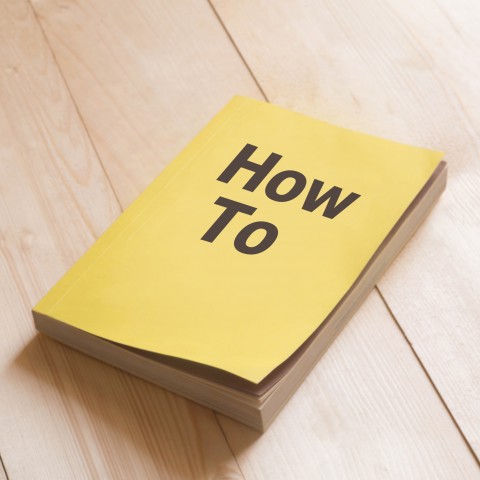
How to Sound Like a Native!
Did you know that we offer the best online Hindi language learning materials out there? From our comprehensive Pronunciation Guide to our free online Hindi-English dictionary and vocabulary lists, HindiPod101.com has everything you need to get started and pave your way to fluency!
As soon as you sign up for a Premium account on HindiPod101.com, you’ll get access to a customized learning pathway especially designed for your needs, starting from the Hindi Basics. In order to learn 24/7, download our mobile app and study anywhere, anytime.
Happy learning!

The Top 10 Answers to “Why Should I Learn Hindi?”

Learning a language is a serious decision. It takes a lot of grit and discipline to master a new language—in this case, Hindi.
As you consider your options, you might start asking yourself: Why learn Hindi? Is it really worth the time and effort?
Of course, the myriad of answers to these questions adds to the confusion and makes it more difficult for you to make a decision.
It’s interesting to see how even genuinely interested people can, at times, generate so many vague excuses to put off Hindi learning. That’s why it’s important to analyze the top reasons for studying Hindi. If nothing else, remembering the “why” helps us stick to our language learning goal and motivates us to do better.
Ready to be inspired? Come and explore how wonderful the language is!
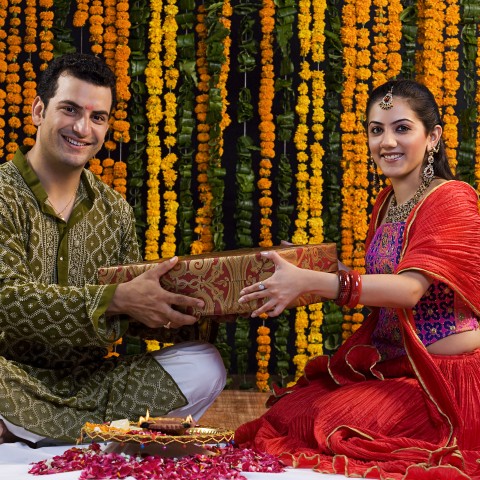
How Well Do You Know Indian Culture?
 Table of Contents
Table of Contents
- The Deep-rooted Hindi-an Culture
- Benefits of Learning a Language
- Personal and Professional Gains
- Hindi is Easy to Learn!
- HindiPod101.com: The Best Platform for Learning Hindi
1. The Deep-rooted Hindi-an Culture
India has made its mark as one of the world’s largest democracies. Its ancient cultural history has enchanted mankind for ages. Being the offspring of Sanskrit—the mother of many languages—Hindi penetrates the old and new social values of Indian society.
1 – Spoken by the Majority!
India has the second highest population in the world, and the majority of this population speaks Hindi.
Indian states like Uttar Pradesh, Bihar, Punjab, Rajasthan, Gujarat, and Delhi speak Hindi and its various dialects as their mother tongue.
Mind you! Uttar Pradesh is the most heavily populated state in India, while Delhi is a melting pot of various cultures and occupants from different states—this naturally adds to the rising number of Hindi speakers.
2- Spiritual / Literary Learning
Every year, people from all over the world love to visit India for spiritual purposes. More often than not, their Indian mentors deliver the discourses in Hindi. In such cases, knowing the Hindi language helps the seeker connect with their Indian Gurus in a more personal way, while allowing them to better understand the context behind the whole learning process.
3 – Global Influence
Another compelling reason to learn Hindi is that this language has impressed the world for so long. Don’t believe us? Apart from India, more than ten nations fall under the category of Hindi-speaking countries.
Even the versatile English language has many loanwords from Hindi. To name a few: Karma, Mantra, Guru, Yoga. Sound familiar?

Language Learning can Improve Your Thinking Process
2. Benefits of Learning a Language
Learning a foreign language comes with several added benefits. For example, the language learning process is known to enhance your cognitive and creative abilities! And did you know that when you’re studying a second language, it actually improves your command of your mother tongue, too?
Trying on a language yet unknown to you is like opening a treasure chest. Once you unlock it, many priceless things come pouring out.
4 – Boost Your Brain Power
Learning a new language activates the neurons and sharpens the thinking process. Not only that, but it also enhances your memory while slowing down the aging process of the brain cells. How cool is that! Working on a second language has proven effects on positive cognitive skills. For instance, your way of thinking changes when the brain tries to create thought patterns in a new language.
5 – It’s So Creative!
Marveling over a completely new language is a creative way to experience the vivid richness of this world and the course of human evolution.
Learning Hindi opens the door to better understanding the Indian culture and gaining first-hand experience when you arrive here.
There are a lot of elements that go missing once a book is translated from the source language to the target language. Learning Hindi will give you much easier access to so many commendable books and Upanishads in their original language. You’ll be able to explore the Hindi literary works of brilliant writers and poets, such as Munshi Premchand, Harivansh Rai Bachchan, and Mahashveta Devi.

Learn Hindi. Get Better Jobs.
3. Personal and Professional Gains
Is India calling?
Whether you want to visit or live here for personal or professional reasons, the bottomline is that you should take a crash course in Hindi first! We cannot emphasize enough how much it’s going to help you.
Let’s look at a few reasons why you should learn Hindi before your visit and examine a few situations where knowing the language can save you from petty troubles.
6 – Be a Bad*ss Tourist!
Traveling has its own set of pros and cons, especially when you’re about to explore a foreign land with a foreign language. Let’s face it: India, known for its mesmerizing natural beauty and countless tourist spots, is a whole new world for many.
We have a totally different culture from what you’re probably used to. Our way of dressing, the Indian cuisine, our style of greeting, and even the popular Indian gestures are enough to puzzle any English speaker. And you can add to that the communication gap!
But once you’re familiar with Hindi survival phrases, things will be much better. As a tourist, Hindi gives you an essential edge while shopping and bargaining, during emergencies, while asking for directions or other kinds of help—not to mention it’s a great way to show off. 😉
7 – Job Opportunities
Are you looking for work in India and wish to improve your chances of getting a job? Or maybe you’re already working in India and want to gel up with your new colleagues? Learning Hindi is a sure way to boost your career, attract many opportunities, and connect with native speakers.
Another great reason to learn Hindi? You’ll finally begin to understand the context and colloquialism of your daily conversations, and have a hearty laugh with your Indian friends/coworkers. As a result, your bonds in the workplace will become stronger. You’ll develop a more solid social network as well.
8 – Bollywood Movies and Songs
Nowadays, people of every nationality and linguistic background are enjoying Bollywood movies and music!
There’s just something about Hindi songs and music that touches the soul and makes our hearts dance to the beats.
If you too are an avid fan, then welcome to our Hindi cult. We can promise that once you’ve started learning Hindi, all the lyrical expressions will make much more sense, and you’ll feel rather connected with the songs and stories depicted in the Hindi-language movies.

Movies, anyone?
9 – When Love’s in the Air!
The world has become a global village. Nowadays, people can easily connect with anyone from anywhere. This connection could turn into an amazing friendship, and who knows—maybe even into a romantic relationship! The point is, there’s nothing more romantic than to have someone learn and express their love in your native language.
So, if you feel kind of crazy in love with a person who speaks Hindi, sweep them off their feet by learning these romantic phrases in Hindi. And if you’re already married to a native Hindi speaker, learning the language could also deepen your bond with your partner and his/her family!
4. Hindi is Easy to Learn!
Sure, Hindi might not sound like a piece of cake when you’ve grown up speaking English or any European language. But it isn’t as difficult as you might imagine. There are many aspects of Hindi which make it quite fun and straightforward to learn. For example:
10 – You Speak as You Write
Each syllable is spoken just as it’s written, thanks to the Devanagari script. Even for beginners, there’s no confusion when it comes to pronouncing Hindi words. Unlike English, which has a twisted way of saying “plough” and “tough” (or “cut” and “put,” for that matter), Hindi pronunciation is much cleaner and simple.

Speak as You Write
In short, each vowel and consonant is spoken just the way it’s written, and this rule never changes. So, once you’ve mastered the ability to read Hindi and recognize the diacritics, you’ve won half the battle. Isn’t that wonderful and relieving to know!
5. HindiPod101.com: The Best Platform for Learning Hindi
Gone are the days when one had to search for a tutor and meet them everyday, in person. Let alone the trouble of getting tied to a fixed time and juggling that into one’s daily schedule. And even if that was an option, what chances are there of doing that during this pandemic?
In such circumstances, the online Hindi learning platform HindiPod101.com offers great value. It’s time-saving, energy-saving, and personalized. What’s more, you can learn Hindi anywhere, anytime, at your convenience. And honestly, why wouldn’t someone be interested when there are as many as 15 ways to learn Hindi for free?

Boost Your Hindi with HindiPod101.com
So, what are you waiting for? Let’s study together at HindiPod101.com and explore the best learning materials. Feeling clueless about where to start? Reach out to our Help Center. Our page First Steps with the System will help you get started smoothly.
All the while, we’ll be waiting to hear your topmost reason to study Hindi. Are you traveling to India or planning to date someone from here? Maybe you’re in love with the Indian music? Whatever it is, we’d love to work with you on this journey!

Tenses in Hindi Made Easy

Today, you’ll learn about tenses in the Hindi language—a crucial topic for any beginner.
Imagine talking about your future plans in the past tense! How puzzling would that be? And that’s just the tip of the iceberg. Without using the correct tenses, it would be difficult for you to express or understand when a given event took place. This would lead to much confusion, not to mention the exchange of incorrect information.
To avoid such embarrassment, you really ought to understand how the grammatical tenses work in Hindi. In our lesson today, we’ll talk about how to form tenses in Hindi and when each one should be used.
It may seem difficult now, but with time, you’ll become familiar with the proper usage of each tense and its subcategories.

What are the Hindi tenses?
Important Note: For more clarity, we’ll be using the same three verbs in Hindi as examples throughout the article. The infinitive forms of these verbs are:
- खाना (khaaNaa) = “to eat”
- जाना (jaaNaa) = “to go”
- सोना (SoNaa) = “to sleep”
 Table of Contents
Table of Contents
- The Different Hindi Verb Tenses
- Present Tense = वर्तमान काल (varTamaaN kaaL)
- Past Tense = भूतकाल (bhuuTakaaL)
- Future Tense = भविष्य काल (bhavisy kaaL)
- Verb Conjugation in Hindi
- Break Through with HindiPod101.com
1. The Different Hindi Verb Tenses
In Hindi grammar, there are three main types of tenses. These are the present tense, past tense, and future tense. Each tense is again divided into three subcategories.
1. Present Tense = वर्तमान काल (varTamaaN kaaL)- a. Simple present
b. Present continuous
c. Present perfect
- a. Simple past
b. Past continuous
c. Past perfect
- a. Simple future
b. Future continuous
c. Future perfect
In the following sections, we’ll be discussing these in the same order. Here we go!

The journey through time
2. Present Tense = वर्तमान काल (varTamaaN kaaL)
The present tense is used when the action is happening at the current moment. The basic types of present tense are simple present, present continuous, and present perfect tense.
A- Simple Present Tense
The simple present tense in Hindi is normally used with indefinite verbs, which are verbs that indicate a fixed pattern, such as a routine or habit.
To help you better understand this concept, here are a few examples.
| Simple Present Tense | |
| अमर सुबह सेब खाता है। amar Subah Seb khaaTaa hai. | “Amar eats an apple in the morning.” |
| पारुल रोज़ स्कूल जाती है। paaruL roz SkuuL jaaTii hai. | “Parul goes to school daily.” |
| बच्चे दोपहर में सोते हैं। bacce Dopahar men SoTe hain. | “The kids sleep in the afternoon.” |
As you can see, each verb form gives us a hint that the said action is taking place on a regular basis.
B- Present Continuous Tense
The present continuous tense in Hindi expresses an action that is happening now, in the exact moment.
In English, this tense is formed by using a conjugated form of the verb “to be” and then adding “-ing” to the end of the root form of the main verb:
- [“to be” verb] + “eat” + “ing” = to be eating
In Hindi, these two steps are replaced by simply using one of these terms:
- रहा है (rahaa hai)
- रही है (rahii hai)
- रहे हैं (rahe hain)
Here are a few examples of how this works:
| Present Continuous Tense | |
| अमर सेब खा रहा है। amar Seb khaa rahaa hai. | “Amar is eating an apple.” |
| पारुल स्कूल जा रही है। paaruL SkuuL jaa rahii hai. | “Parul is going to school.” |
| बच्चे सो रहे हैं। bacce So rahe hain. | “The kids are sleeping.” |

Being in the present moment
C- Present Perfect Tense
We use the present perfect tense to indicate that an action was completed not long ago.
In English, you would form this tense by using the auxiliary “has” or “have,” followed by the third form of the main verb. For example:
- has / have + eaten
In Hindi, you would replace the “has” or “have” with one of these terms:
- चुका है (cukaa hai)
- चुकी है (cukii hai)
- चुके हैं (cuke hain)
Let’s take a look:
| Present Perfect Tense | |
| अमर सेब खा चुका है। amar Seb khaa cukaa hai. | “Amar has eaten an apple.” |
| पारुल स्कूल जा चुकी है। paaruL SkuuL jaa cukii hai. | “Parul has gone to school.” |
| बच्चे सो चुके हैं। bacce So cuke hain. | “The kids have gone to sleep.” |
3. Past Tense = भूतकाल (bhuuTakaaL)
The past tense in Hindi is used to talk about events that have already taken place. The most commonly used subcategories of this tense are the simple past, past continuous, and past perfect.
A- Simple Past Tense
In Hindi, we use either indefinite verbs or the second form of verbs to make the simple past tense. This tense can be used to indicate a past habit or the completion of an action in the past.

I loved the dinner last night!
Here are some examples of what the simple past tense in Hindi looks like:
| Simple Past Tense | |
| अमर ने सेब खाया। amar Ne Seb khaayaa. Or अमर सेब खाता था। amar Seb khaaTaa THaa. | “Amar ate an apple.” Or “Amar used to eat an apple.” |
| पारुल स्कूल गयी। paaruL SkuuL gayii. Or पारुल स्कूल जाती थी। paaruL SkuuL jaaTii THii. | “Parul went to school.” Or “Parul used to go to school.” |
| बच्चे सोये। bacce Soye. Or बच्चे सोते थे। bacce SoTe THe. | “The kids slept.” Or “The children used to sleep.” |
B- Past Continuous Tense
We use the past continuous tense to describe a continuous action that was taking place at a specific time in the past.
In English, this tense is formed by using the auxiliary “was” or “were,” followed by the root form of the main verb + “-ing.” For example:
- [was / were] + eat + ing = was/were eating
In Hindi, you would replace these two elements with one of these terms:
- रहा था (rahaa THaa)
- रही थी (rahii THii)
- रहे थे (rahe THe)
Here are some examples for you:
| Past Continuous Tense | |
| अमर सेब खा रहा था। amar Seb khaa rahaa THaa. | “Amar was eating an apple.” |
| पारुल स्कूल जा रही थी। paaruL SkuuL jaa rahii THii. | “Parul was going to school.” |
| बच्चे सो रहे थे। bacce So rahe THe. | “The kids were sleeping.” |
C- Past Perfect Tense
The past perfect tense is used to express actions that were performed and completed in the past.
In English, you would form this tense by using the auxiliary “had,” followed by the third form of the main verb:
- [had] + eaten = had eaten
In Hindi, the auxiliary “had” is replaced by one of these terms:
- चुका था (cukaa THaa)
- चुकी थी (cukii THii)
- चुके थे (cuke THe)
For example:
| Past Perfect Tense | |
| अमर सेब खा चुका था। amar Seb khaa cukaa THaa. | “Amar had eaten an apple.” |
| पारुल स्कूल जा चुकी थी। paaruL SkuuL jaa cukii THii. | “Parul had gone to school.” |
| बच्चे सो चुके थे। bacce So cuke THe. | “The kids had slept.” |
4. Future Tense = भविष्य काल (bhavisy kaaL)
We’ve finally arrived at the future tense!
The future tense in Hindi is used to talk about events that are yet to take place. The most commonly used future tenses are the simple future, future continuous, and future perfect.
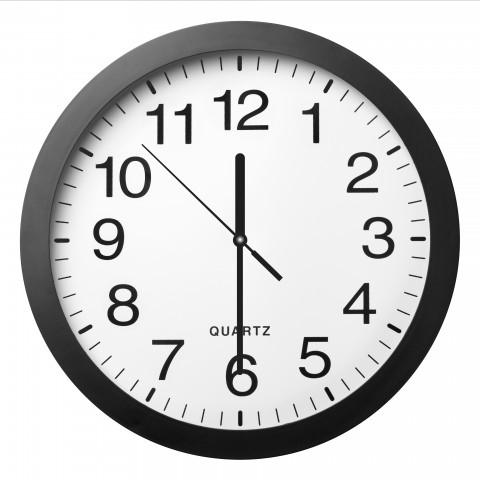
Will you meet me tomorrow?
A- Simple Future Tense
As the name suggests, the simple future tense indicates activities that are certain to happen in the future.
Note in the examples below that all three sentences end with either गा (gaa), गी (gii), or गे (ge). This is the trademark of the future tense in Hindi.
| Simple Future Tense | |
| अमर सेब खाएगा। amar Seb khaayegaa. | “Amar will eat an apple.” |
| पारुल स्कूल जाएगी। paaruL SkuuL jaayegii. | “Parul will go to school.” |
| बच्चे सोएंगे। bacce Soyenge. | “The kids will sleep.” |
B- Future Continuous Tense
Similarly to the present and past continuous, the future continuous tense also contains the term रहा (rahaa). The only difference is that, in the future continuous tense, it’s followed by either होगा (hogaa), होगी (hogii), or होंगे (honge).
In English, this tense is formed by using the auxiliary “will be,” followed by the first form of the main verb + “-ing.” For example:
- [will be] + “eat” + “ing” = will be eating
In Hindi, however, you replace these elements with one of these terms:
- रहा होगा (rahaa hogaa)
- रही होगी (rahii hogii)
- रहे होंगे (rahe honge)
Here are some examples for you:
| Future Continuous Tense | |
| अमर सेब खा रहा होगा। amar Seb khaa rahaa hogaa. | “Amar will be eating an apple.” |
| पारुल स्कूल जा रही होगी। paaruL SkuuL jaa rahii hogii. | “Parul will be going to school.” |
| बच्चे सो रहे होंगे। bacce So rahe honge. | “The kids will be sleeping.” |
C- Future Perfect Tense
To form the future perfect tense in English, you would use the auxiliary “will have” or “shall have,” followed by the third form of the main verb:
- [will have / shall have] + eaten = will/shall have eaten
In Hindi, you would replace the auxiliary with one of these terms:
- चुका होगा (cukaa hogaa)
- चुकी होगी (cukii hogii)
- चुके होंगे (cuke honge)
| Future Perfect Tense | |
| अमर सेब खा चुका होगा। amar Seb khaa cukaa hogaa. | “Amar will have eaten an apple.” |
| पारुल स्कूल जा चुकी होगी। paaruL SkuuL jaa cukii hogii. | “Parul will have gone to school.” |
| बच्चे सो चुके होंगे। bacce So cuke honge. | “The kids will have gone to sleep.” |
Now that we’ve covered several of the common Hindi tenses with examples, it’s time to learn a little bit about verb conjugation in sentences.
5. Verb Conjugation in Hindi
Did you know that the Hindi language is quite peculiar when it comes to verb conjugation?
There are three factors that influence the conjugation of Hindi verbs:
- Tense
- Gender
- Number
You’ve already seen a glimpse of verb conjugation in the examples above, but how about we break it down a little more using all three factors?
| Tenses and Verb Conjugation | ||||
| Tense | Masculine Gender | Feminine Gender | ||
| Singular | Plural | Singular | Plural | |
| Simple Present | – ता है (Taa hai) | – ते हैं (Te hain) | – ती है (Tii hai) | – ती हैं (Tii hain) |
| Present Continuous | – रहा है (rahaa hai) | – रहे हैं (rahe hain) | – रही है (rahii hai) | – रही हैं (rahii hain) |
| Present Perfect | – चुका है (cukaa hai) | – चुके हैं (cuke hain) | – चुकी है (cukii hai) | – चुकी हैं (cukii hain) |
| Simple Past | – ता था (Taa THaa) | – ते थे (Te THe) | – ती थी (Tii THii) | – ती थीं (Tii THiin) |
| Past Continuous | – रहा था (rahaa THaa) | – रहे थे (rahe THe) | – रही थी (rahii THii) | – रही थीं (rahii THiin) |
| Past Perfect | – चुका था (cukaa THaa) | – चुके थे (cuke THe) | – चुकी थी (cukii THii) | – चुकी थीं (cukii THiin) |
| Simple Future | – गा (gaa) | – गे (ge) | – गी (gii) | – गीं (giin) |
| Future Continuous | – रहा होगा (rahaa hogaa) | – रहे होंगे (rahe honge) | – रही होगी (rahii hogii) | – रही होंगी (rahii hongii) |
| Future Perfect | – चुका होगा (cukaa hogaa) | – चुके होंगे (cuke honge) | – चुकी होगी (cukii hogii) | – चुकी होंगी (cukii hongii) |
6. Break Through with HindiPod101.com
Tenses in Hindi might appear a bit confusing in the beginning. But just like in English, there are fixed patterns of main and auxiliary verbs in Hindi; learning them will make this aspect of the language so much easier for you! We hope you found this lesson useful and interesting.

Let’s work toward a better future.
What things do you find the easiest and most difficult about Hindi tenses so far? Could you add some more examples for each category? Well, we’re all ears!
Remember that no matter your current Hindi level, we’re here to help you learn every step of the way. Polish your Hindi skills by studying with our world-class vocabulary resources and practicing with flashcards. For even more accessibility, download our mobile app and get going.
Keep learning, keep shining!

Our 2021 Guide on How to Learn Hindi Fast!

Many aspiring students long to know the estimated duration of their Hindi learning—and this makes perfect sense! Without a well-defined deadline, one could easily derail from the language learning path. It would be like traveling to an undisclosed destination with no idea of when you would reach it.
If you’re like most aspiring Hindi language learners, you probably have this important question on your mind: How long does it take to learn Hindi?
In this article, we will…
- …give you an outline of how long it takes to reach each level of Hindi.
- …offer you some tips on how to learn Hindi fast.
- …provide you with some motivational facts to keep you going strong.
It’s natural to be curious, and you might also be wondering how difficult it is to learn the Hindi language. You can check out the following article to discover the hardest (and easiest) parts of the language: Is Hindi Hard to Learn? Our Verdict.
Now, are you ready to unpack the topic at hand?

Cracking the Hindi Learning Code
 Table of Contents
Table of Contents
- Why Should You Know How Long it Takes to Learn Hindi?
- How Long Does it Take to Achieve Beginner Level?
- How Long Does it Take to Achieve Intermediate Level?
- How Long Does it Take to Achieve Advanced Level?
- Motivational Facts
- How to Use HindiPod101.com to the Fullest
1. Why Should You Know How Long it Takes to Learn Hindi?
It’s important to get a fair idea of how long it will take to learn Hindi because this will help you set a realistic language learning goal and develop a suitable strategy. Once you have an approximate duration in mind, you’re ready to assign the required time and energy in a balanced manner. This way, you can work toward your goals without feeling crushed!
Before moving forward, we’d like to remind you that, according to the ILTS TLP Hindi proficiency test, there are three levels of Hindi proficiency: beginner, intermediate, and advanced. Each level requires a different time commitment from the student. Read on to learn more about what each level looks like and how to reach them effectively.
2. How Long Does it Take to Achieve Beginner Level?
The answer to this question depends on a number of factors, such as your study methods and how much time you spend actively learning.
If you’re consistently in touch with native speakers, watch Hindi movies and shows, and listen to Hindi podcasts every day, then you’ll be able to pick up the basics within 3-4 months.
Clueless where to begin? Our blog is a great place to get ideas! See our posts on:
As a beginner, it’s a good idea to start by learning the Devanagari script used for reading and writing, some popular Hindi greetings, and common Hindi words that are used on a daily basis. Once you have a solid foundation in those areas, slowly begin to focus on the pronunciation, diacritics, and conjugations, as these are quite unique and crucial to the Hindi language.

Practicing with the Native Friends
Here are a few simple Hindi words and phrases for beginners:
- नमस्ते। (NamaSTe.) = “Hello.”
- कैसी हैं आप? (kaiSii hain aap?) = “How are you?” [to a female]
- कैसे हैं आप? (kaiSe hain aap?) = “How are you?” [to a male]
- मैं ठीक हूँ। (main thiik huun.) = “I am fine.”
- धन्यवाद। (DHaNyavaaD.) = “Thank you.”
- आपका नाम क्या है? (aapakaa Naam kyaa hai?) = “What is your name?”
- मेरा नाम ___ है। (meraa Naam ___ hai.) = “My name is ____.”
Although it normally takes one a few months to master the key Hindi phrases, you don’t have to wait that long! How, you ask? By working on your reading skills and listening skills right away, you can increase your pace and pick up the basics faster than other people.

Having the Right Strategy is Important!
Helpful Links
There’s a lot of ground to cover at this stage of your Hindi learning! To give you a headstart on the basic phrases you should know, HindiPod101.com has comprehensive lessons on the following topics:
We also provide our students with spaced repetition flashcards. Reviewing them once in a while is a wonderful way to easily memorize new words and retain them for longer.
In addition to picking up new vocabulary, you should focus on learning the basic rules of Hindi grammar and syntax. For example, did you know that Hindi uses a different sentence structure than English does? Hindi is an SOV language, while English is an SVO language.
Each of our beginner lessons features a dialogue by native speakers, a vocabulary list of relevant words and phrases, and lesson notes to summarize the main points. You can also download a PDF of the lesson transcript to keep it handy! We recommend you start with our Absolute Beginner Pathway, which covers everything you should know before pressing onward toward the intermediate level.
3. How Long Does it Take to Achieve Intermediate Level?
According to the U.S. Foreign Service Institute (FSI), English speakers can reach an intermediate level of Hindi in 3 months, given that they study consistently for an hour each day. But if you wish to take your Hindi learning more lightly and at a slower pace, 6-8 months could do the job!
Once you achieve this level, you’ll be able to…
- …have fluent informal conversations.
- …pronounce unfamiliar sounds correctly.
- …follow Hindi conjugation rules in a flawless manner.

Daily Speaking is the Key!
Helpful Links
The journey from beginner to intermediate is long, with lots of progress made along the way. Wondering how to learn Hindi effectively at this point? HindiPod101.com has you covered!
As mentioned, you should be able to hold informal conversations at this level. This includes things like…
Pronunciation is another huge factor at this point. Did you know that many of the sounds in Hindi are completely new to English speakers? The good news is that, within 6 months, most students are ready to flaunt their improved pronunciation skills!
Before you reach the intermediate level, you should also be quite familiar with the different parts of speech in Hindi:
4. How Long Does it Take to Achieve Advanced Level?
You’ve made a ton of progress by now, but there’s still a ways to go. How long does it take to learn Hindi fluently? For most learners, this process takes about 1100 hours (or about 3 years) of consistent study—but the payoff is worth it!
Once you reach the advanced level, you’ll be able to make formal conversation and understand many different colloquial expressions. You’ll be more than capable of using Hindi in a variety of day-to-day situations!
Helpful Links
Reaching the advanced level means that you not only know the language, but that you understand how to apply it in the context of Indian culture. This means having a good working knowledge of…
- …gender rules and conjugations.
- …various tenses.
- …Indian etiquette.
- …local idioms and proverbs.
- …untranslatable words.
- …slang terms.

Think Beyond the Books
5. Motivational Facts
Learning the Hindi language isn’t easy, but there are plenty of reasons to stick with it anyway. Here are some motivational facts to keep you going strong!
- Not everyone in India speaks Hindi correctly. India is a land of several languages and countless dialects. It’s possible to meet Indian people who know not a single word of Hindi.
At the same time, there are those who speak (or are trying to learn) Hindi as a second or third language. Their mother tongue is likely an Indian regional language such as Telugu, Tamil, or Kannada, and English is their second language.
So, chillax if you’re still a beginner at Hindi; you can find many Indians who have less command over Hindi than you do!
- Having an accent is acceptable. Indian people are quite supportive when it comes to foreigners having an accent or struggling with the right pronunciation. If it’s any consolation, there are some local folks who have an accent in English as well as in Hindi. And we’re totally okay with that!
- It gets better and easier with time. The more time you spend learning and practicing Hindi, the more fluent you’ll get at it. If you enjoy watching movies and listening to songs, use those hobbies to learn Hindi. Pick any artist or movie genre of your choice in Hindi and focus on the words and pronunciation.
Running out of time? Plug in your earphones while you work out, do the dishes, or walk to that nearby park. Daily activities like these are golden opportunities to learn Hindi. You can use the time to listen to simple Hindi podcasts, songs, or the daily news.
- How quickly you learn depends a lot on your background and mother tongue. What if you’re not a native English speaker? Hindi shares a lot of sounds with and has loanwords from languages like Russian, Arabic, Persian, and even French. Language learners from those particular countries have an edge when it comes to unfamiliar sounds in Hindi.
- We use lots of English words in daily spoken Hindi. To give you just a sample, you’ll find the following words used in the Hindi language: “bus” / “train” / “hospital” / “nurse” / “doctor” / “time” / “bread” / “coffee” / “computer.” This is quite helpful because you can easily bank upon these English words to communicate, even if you don’t know the Hindi words for them.
- We speak as we write. There’s no hidden pronunciation rules or guesswork. Unlike English, where the pronunciation of a given letter or letter combination varies greatly from one word to another, Hindi is predictable and straightforward. You can’t explain why “rough” cannot be spoken as “plough,” or “cut” as “put”? Well, you don’t have to struggle with these inexplicable rules in Hindi. The phonetics-based Devanagari script used in Hindi makes sure that each word is spoken exactly as it’s written.
6. How to Use HindiPod101.com to the Fullest
If you’ve decided to learn Hindi, HindiPod101.com is ready to offer you the best online study materials to make your journey that much smoother.
Did you know that there are 15 ways to study Hindi free at HindiPod101.com! No? Then features like our Grammar Bank are sure to sweep you off your feet. Just type in any keyword/topic you wish to study, and the Grammar Bank will display the whole list of related lessons.

The Top 30 Proverbs in Hindi to Impress Native Speakers

Hindi is a rich and colorful language, so it should come as no surprise that proverbs are a huge part of daily life in India. Learning proverbs in Hindi is an excellent way to gain a deeper understanding of Indian culture while expanding your vocabulary at the same time!
In our lesson today, we’ll introduce you to the most widely used Hindi proverbs and their meanings. We intend for this to be a useful Hindi learning tool for intermediate learners as well as beginners, so our list of proverbs in Hindi will cover only the sayings you’re most likely to hear while in India.
Let’s get started!
 Table of Contents
Table of Contents
1. How Relevant Are Hindi Proverbs?
To Indians, Hindi proverbs are more than a bunch of literary phrases or clever sayings. We’ve been hearing these words of wisdom from our grandparents and parents since childhood. It would be no exaggeration to say that using and hearing these proverbs takes us back to our childhood—and who doesn’t love that?
As a Hindi learner, being able to use Hindi proverbs correctly will give you an edge and help you stand out from the crowd. Our Hindi proverbs list will give you the information and tips you need to sound smart, grasp the context of each proverb quickly, and contribute to any conversation that comes your way.
- → If you’re looking to add even more flair to your Hindi conversations, then make sure to check out our vocabulary list of the Essential Idioms That Will Make You Sound Like a Native Speaker.
→ And if you’re a beginner, you may find it useful to study our Hindi Pronunciation Guide before continuing.
2. Hindi Proverbs List
Below you’ll find thirty of the most common Hindi proverbs covering a range of topics. For your convenience, we’ve also included their literal translations, their meanings, and how to use them in the right context.
#1 जब जागो तब सवेरा (jab jaago Tab Saveraa)
Literal Translation: “Whenever you wake up, that’s your morning.”
Similar English Proverb: “Better late than never.”
Usage in Context: It’s never too late to realize your mistake. Imagine a person who’s careless and insensitive to his/her spouse. Their marriage is about to break. But before it gets to that point, the person realizes their mistake, changes their behavior, and saves the marriage.
Example Sentence:
हेमा ने अपनी ग़लती समझकर अपनी शादी बचा ली। ये तो वही बात हुई, जब जागो तब सवेरा।
(hemaa Ne apaNii gaLaTii Samajhakar apaNii saaDii bacaa Lii. ye To vahii baaT huii, jab jaago Tab Saveraa.)
“Hema realized her mistake and saved her marriage from falling apart. This is what we call, ‘better late than never’.”

Better late than never!
#2 अधजल गगरी छलकत जाये (aDHajaL gagarii chaLakaT jaaye)
Literal Translation: “A half-filled container spills more water.”
Similar English Proverb: “An empty vessel makes the most noise.”
Usage in Context: Imagine you’re an expert at painting while your friend is just a beginner. But when sitting around with others, he boasts a lot about painting as if he knows everything.
Example Sentence:
सुनील पेंटिंग के बारे में ऐसे बात करता है जैसे उसे सब कुछ पता हो। अधजल गगरी छलकत जाये।
(SuNiiL peNting ke baare men aiSe baaT karaTaa hai jaiSe uSe Sab kuch paTaa ho. aDHajaL gagarii chaLakaT jaaye.)
“Sunil is just a beginner but he talks about painting as if he knows everything. It’s true, ‘an empty vessel makes the most noise’.”
#3 नाच न जाने आँगन टेढ़ा (Naac Na jaaNe aangaN tedhaa)
Literal Translation: “Not knowing how to dance but calling the courtyard crooked.”
Similar English Proverb: “A bad workman blames his tools.”
Usage in Context: A friend of yours doesn’t know how to cook, but instead of admitting so, he always gives one excuse or another for his bad cooking.
Example Sentence:
पुनीत को खाना बनाना नहीं आता और वह हर बार कुछ गड़बड़ कर देता है। लेकिन अपनी ग़लती मानने की बजाय वो बर्तनों में नुक्स निकालता है। सच ही है, नाच न जाने आँगन टेढ़ा।
(puNiiT ko khaaNaa baNaaNaa Nahiin aaTaa aur vah har baar kuch gadabad kar DeTaa hai. LekiN apaNii gaLaTii maaNaNe kii bajaaye vo barTaNon men NukS NikaaLTaa hai. Sac hii hai, Naac Na jaaNe aangaN tedhaa.)
“Punit doesn’t know how to cook and he ruins the food all the time. But he will never admit it and always blames the cooking pots. He reminds us of the proverb, ‘a bad workman blames his tools’.”
#4 उल्टा चोर कोतवाल को डांटे (uLataa cor koTavaaL ko daante)
Literal Translation: “When caught, the thief scolds the policeman.”
Similar English Proverb: “Pot calling the kettle black.”
Usage in Context: Suppose you’re buying some items from the grocery store. The shopkeeper tries to cheat you and doesn’t give you the due change—when you point it out, he begins to argue with you.
Example Sentence:
Customer: आपने मुझे पैसे वापस नहीं दिए। (aapaNe mujhe paiSe vaapaS Nahiin Diye.)
“You didn’t return me the balance.”
Shopkeeper: मैंने तो वापस दिए थे। आप झूठ मत बोलिये। (maiNe To vaapaS Diye THe. aap jhuuth maT boLiye.)
“I did. You are lying.”
Customer: अच्छा! उल्टा चोर कोतवाल को डांटे! (acchaa! uLataa cor koTavaaL ko daante!)
“Oh! So, the pot’s calling the kettle black!”
#5 जान है तो जहान है (jaaN hai to jahaaN hai)
Literal Translation: “If there is life, then there is the world.”
Similar English Proverb: “Health is wealth.”
Usage in Context: Some people overwork themselves and ignore their health in the process. They forget the value of a healthy body and peaceful mind.
Example Sentence:
A: फ़रहा ने चार महीनों से एक भी छुट्टी नहीं ली है। इस वजह से वो कमज़ोर होती जा रही है।
(farahaa Ne caar mahiiNon Se ek bhii chuttii Nahiin Lii hai. iS vajah Se vo kamazor hoTii jaa rahii hai.)
“Farah has not taken any leave in four months. That’s why she is getting weaker.”
B: हाँ, उसे कुछ दिन घर पर रहकर आराम करना चाहिए। आख़िर, जान है तो जहान है।
(haan, uSe kuch DiN ghar par rahakar aaraam karaNaa caahiye. aakhir, jaaN hai To jahaaN hai.)
“Yes, she should stay at home and take rest for a few days. After all, health is wealth.”

Health is Wealth!
#6 जिस की लाठी उसकी भैंस (jiSakii Laathii uSakii bhainS)
Literal Translation: “The buffalo belongs to the person who holds a stick.”
Similar English Proverb: “Might is right.”
Usage in Context: In modern times, virtues like honesty and loyalty hardly seem to matter. Oftentimes, the wrong people get their way by using their power and money.
Example Sentence:
A: बेईमान नेता ने उस ईमानदार अधिकारी का तबादला करवा दिया। (beiimaaN NeTaa Ne uS iimaaNaDaar aDHikaarii ka TabaaDaLaa karavaa Diyaa.)
“The corrupt minister got the honest officer transferred.”
B: हाँ, जिसकी लाठी उसकी भैंस। (haan, jiSakii Laathii uSakii bhainS)
“Yeah, might is right.”
#7 अब पछताए होत क्या जब चिड़िया चुग गई खेत (ab pachaTaaye hoT kyaa jab cidiyaa cug gayii kheT)
Literal Translation: “There’s no use repenting when the birds have already damaged the crops in the field.”
Similar English Proverb: “There’s no use crying over spilled milk.”
Usage in Context: You might use this proverb after someone neglects to finish their work and ends up regretting it.
Example Sentence:
A: करन उदास था। वह भर्ती परीक्षा नहीं दे पायेगा क्योंकि उसने फ़ॉर्म समय पर नहीं जमा किया था।
(karaN uDaaS THaa. vah bharTii pariiksaa Nahiin De paayegaa kyonki uSaNe form Samay par Nahiin jamaa kiyaa THaa.)
“Karan was sad as he will miss the entrance exam because he didn’t submit the form on time.”
B: अब क्या हो सकता है! अब पछताए होत क्या जब चिड़िया चुग गयी खेत।
(ab kyaa ho SakaTaa hai! ab pachaTaaye hoT kyaa jab cidiyaa cug gayii kheT.)
“What can be done now! There’s no use crying over spilled milk.”

Do you have regrets in life?
#8 दूध का जला छाछ भी फूंक कर पीता है (DuuDH kaa jaLaa chaach bhii phuunk kar piiTaa hai)
Literal Translation: “The person who’s burned from milk is scared of buttermilk too.”
Similar English Proverb: “Once bitten twice shy.”
Usage in Context: A person who almost drowned once while trying to get on a boat will always be scared of doing so in the future.
Example Sentence:
A: चलो, नाव पर चलें। (caLo, Naav par caLen)
“Come on, let’s go boating.”
B: नहीं, एक बार मैं नदी में डूबते-डूबते बचा था। मुझे डर लगता है। (Nahiin, ek baar main NaDii men duubaTe-duubaTe bacaa THaa. mujhe dar LagaTaa hai.)
“No, once I was about to drown in a river. I am scared of boating.”
A: ओह! सच है कि दूध का जला छाछ भी फूंक कर पीता है। (oh! Sac hai ki DuuDH kaa jaLaa chaach bhii phuunk kar piiTaa hai.)
“Oh! It’s true. Once bitten twice shy.”
#9 चोर-चोर मौसेरे भाई (cor-cor mauSere bhaaii)
Literal Translation: “Two thieves are just like cousins.”
Similar English Proverb: “Birds of a feather flock together.”
Usage in Context: This proverb might be used when two mischievous people bond and support each other like nobody else.
Example Sentence:
सभी बेईमान नेता हर घोटाले में एक दूसरे की मदद करते हैं। चोर-चोर मौसेरे भाई।
(Sabhii beiimaaN NeTaa har ghotaaLe men ek DuuSare kii maDaD karaTe hain. cor-cor mauSere bhaaii.)
“All the corrupt ministers support each other in every scam. Birds of a feather flock together.”
#10 जैसी करनी वैसी भरनी (jaiSii karaNii vaiSii bharaNii)
Literal Translation: “What you receive is the consequence of your actions.”
Similar English Proverb: “As you sow, so you shall reap.”
Usage in Context: When someone does something bad to another person, karma finds its way back.
Example Sentence:
A: सोहन ने रेस जीतने के लिए कमल को धक्का दे दिया। लेकिन जज ने उसे ही रेस से बाहर कर दिया।
(SohaN Ne reS jiiTaNe ke Liye kamaL ko Dhakkaa De Diyaa. LekiN jaj Ne uSe hii reS Se baahar kar Diyaa.)
“Sohan pushed Kamal to win the race. But the judge saw and put him out of the race.”
B: बहुत अच्छा हुआ। जैसी करनी वैसी भरनी।
(bahuT acchaa huaa. jaiSii karaNii vaiSii bharaNii.)
“Good. As you sow, so you shall reap.”
#11 ऊँट के मुंह में जीरा (uunt ke munh men jiiraa)
Literal Translation: “A pinch of cumin seeds in the camel’s mouth.”
Similar English Proverb: “A drop in the bucket.”
Usage in Context: This one depicts a situation where a person gets way less than he/she needs.
Example Sentence:
भारत में किसानों को बाज़ार से जो पैसा मिलता है वह ऊंट के मुंह में जीरे के बराबर है।
(bhaaraT men kiSaaNon ko baazaar Se jo paiSaa miLaTaa hai vah uunt ke munh men jiire ke baraabar hai)
“In India, the profit farmers get from the market is like a drop in the bucket.”
#12 अंत भला तो सब भला (aNT bhaLaa To Sab bhaLaa)
Literal Translation: “If it’s a happy ending, then everything was worth it.”
Similar English Proverb: “All’s well that ends well.”
Usage in Context: You could use this proverb after enduring several hurdles to find that everything ended just like you wanted it to.
Example Sentence:
पूरी फ़िल्म में हीरो हर क़दम पर मात खाता रहा। लेकिन बाद में उसने अपनी मंज़िल पा ली। इसे कहते हैं अंत भला तो सब भला।
(puurii fiLm men hiiro har kaDam par maaT khaaTaa rahaa. LekiN baaD men uSaNe apaNii maNziL paa Lii. iSe kahaTe hain anT bhaLaa To Sab bhaLaa.)
“During the whole movie, the hero kept failing at every stage. But then, he achieved his goal. This is called ‘all’s well that ends well’.”

All’s well that ends well.
#13 दूर के ढोल सुहावने लगते हैं (Duur ke dhoL SuhaavaNe LagaTe hain)
Literal Translation: “Distant drums sound pleasant.”
Similar English Proverb: “The grass is always greener on the other side.”
Usage in Context: We always end up thinking that other people have better lives or better things than we do, which is not always true. It’s just that we’re not fully aware of the reality.
Example Sentence:
लोग विदेश जाने के लिए पागल हैं लेकिन वो ये नहीं समझते कि वहां की अपनी अलग दिक्कतें हैं। असल में, दूर के ढोल सुहावने लगते हैं।
(Log viDes jaaNe ke Liye paagaL hain LekiN vo ye Nahiin SamajhaTe ki vahaan kii apaNii aLag DikkaTen hain. aSaL men, Duur ke dhoL SuhaaavaNe LagaTe hain.)
“People are crazy about moving to other countries. However, they don’t realize that there will be other kinds of problems. Actually, distant drums sound pleasant.”
#14 आगे कुंआ पीछे खाई (aage kunaan piiche khaaii)
Literal Translation: “A well in front and a ditch behind.”
Similar English Proverb: “Between the devil and the deep blue sea.”
Usage in Context: You might use this saying to describe a situation where you’re surrounded by troubles from all sides and feel stuck in life.
Example Sentence:
नोटबंदी में पुराने नोट बंद हो गए और एटीएम में पैसे नहीं। यानी आगे कुआँ पीछे खाई।
(NotabanDii men puraaNe Not banD ho gaye aur e-tii-em men paiSe Nahiin. yaaNii aage kunaan piiche khaaii.)
“During demonetization, the old notes were scrapped and there was no money in the ATM machines. It was like being stuck between the devil and the deep blue sea.”
#15 डूबते को तिनके का सहारा (DuubaTe ko TiNake kaa Sahaaraa)
Literal Translation: “To a drowning person, even a grain could be a great help.”
Similar English Proverb: “Drowning man catches at a straw.”
Usage in Context: When going through a really tough time, even the smallest bit of help can mean a lot.
Example Sentence:
जब सुमन का बिज़नेस ठप हो गया था, तो उसके दोस्तों ने पैसे जुटाकर उसकी मदद की। मुसीबत के समय में डूबते को तिनके का सहारा भी काफ़ी होता है।
(jab SumaN kaa bizaNeS thap ho gayaa THaa, To uSake DoSTon Ne paiSe jutaakar uSakii maDaD kii. muSiibaT ke Samay men DuubaTe ko TiNake kaa Sahaaraa bhii kaafii hoTaa hai.)
“When Suman’s business was in a huge loss, her friends pooled some money to help her out. And Suman was like a drowning man who catches at a straw.”
#16 बन्दर क्या जाने अदरक का स्वाद (baNDar kyaa jaaNe aDarak kaa svaaD)
Literal Translation: “How would a monkey know the taste of ginger!”
Similar English Proverb: “Casting pearls before swine.”
Usage in Context: You may give a person the most useful thing in the world, but it won’t impress them if they don’t know its value.
Example Sentence:
हर कोई अच्छी क़िताबों का महत्व नहीं समझता। सच है, बन्दर क्या जाने अदरक का स्वाद।
(har koii acchii kiTaabon kaa mahaTva Nahiin SamajhaTaa. Sac hai, baNDar kyaa jaaNe aDarak kaa SvaaD.)
“Not everyone understands the value of good books. It’s like casting pearls before swine.”
#17 सौ सुनार की, एक लोहार की (Sau SuNaar kii, ek Lohaar kii)
Literal Translation: “Hundred blows of a goldsmith, single blow of a blacksmith.”
Similar English Proverb: “A single blow of a blacksmith is equal to a hundred blows of a goldsmith.”
Usage in Context: Some people may bother you or keep complaining about every little thing, but you can shut them up at once by drawing a bigger line.
Example Sentence:
नेता रोज़ झूठे वादे करता था। जनता ने उसके ख़िलाफ़ वोट देकर एक ही बार में उसे हरा दिया। इसे कहते हैं, सौ सुनार की एक लोहार की।
(NeTaa roz jhuuthe vaaDe karaTaa THaa. jaNTaa Ne uSake khiLaaf vot Dekar ek hii baar men uSe haraa Diyaa. iSe kahaTe hain, Sau SuNaar kii, ek Lohaar kii.)
“The minister would always over-promise things. The public voted against him and kicked him out at once. This is called ‘a single blow of a blacksmith is equal to a hundred blows of a goldsmith’.”
#18 नेकी कर दरिया में डाल (Nekii kar Dariyaa men daaL)
Literal Translation: “Help others and drop the thought in the river.”
Similar English Proverb: “Do good and cast into the river.”
Usage in Context: Kindness loses its value when the doer tries to flaunt it. True compassion is always a secret.
Example Sentence:
भले लोग छुप कर ग़रीबों की मदद करते हैं। वो नेकी कर दरिया में डाल देते हैं।
(BHaLe Log chup kar gariibon kii maDaD karaTe hain. Vo Nekii kar Dariyaa men daaL DeTe hain.)
“Kind-hearted people help the poor in secret. They do good and cast into the river.”

Help someone and forget about it.
#19 घर का भेदी लंका ढाये (ghar kaa BHeDii Lankaa dhaaye)
Literal Translation: “The person knowing the secrets of the house can cause the fall of Lanka.”
Similar English Proverb: “A small leak will sink a great ship.”
Usage in Context: One inside person can reveal all the secrets and cause irreparable damage.
Example Sentence:
मधुर ने अपनी कंपनी के सारे प्लान दूसरी कंपनी को बता दिए और प्रॉजेक्ट दूसरों को मिल गया। सच ही है, घर का भेदी लंका ढाये।
(maDHur Ne apaNii kampaNii ke Saare pLaaN DuuSarii kampaNii ko baTaa Diye aur projekt DuuSaron ko miL gayaa.)
“Madhur revealed all the plans of his company to others and someone else got the project. It’s true that a small leak will sink a great ship.”
#20 बोये पेड़ बबूल का तो आम कहाँ से पाए (boye ped babuuL kaa To aam kahaan Se paaye)
Literal Translation: “If you have sown the seeds of acacia, how would you get mangoes from it?”
Similar English Proverb: “You will reap what you sow.”
Usage in Context: When we do something wrong, we sometimes fail to think of its consequences. But life gives us exactly what we deserve.
Example Sentence:
जतिन ने कभी अपने बेटे से प्यार नहीं किया और अब उसका बेटा उससे बात तक नहीं करता। वही बात है कि बोये पेड़ बबूल का तो आम कहाँ से पाए।
(jaTiN Ne kabhii apaNe bete Se pyaar Nahiin kiyaa aur ab uSakaa betaa uSaSe baaT Tak Nahiin karaTaa. Vahii baaT hai ki boye ped babuuL kaa To aam kahaan Se paaye.)
“Jatin never loved his son and now his son doesn’t even talk to Jatin. They say, you will reap what you sow.”
#21 मुंह में राम, बगल में छुरी (munh men raam, bagaL men churii)
Literal Translation: “Name of Lord Rama on the tongue and hiding a knife in the side.”
Similar English Proverb: “A honey tongue, a heart of gall.”
Usage in Context: Many people lack authentic behavior. They may say all the sweet things to your face but badmouth behind your back.
Example Sentence:
बबिता सामने तो बहुत अच्छे से बात करती है लेकिन पीठ पीछे काजल की बुराई करती है। इसे कहते हैं मुंह में राम, बगल में छुरी।
(babiTaa SaamaNe To bahuT acche Se baaT karaTii hai LekiN piith piiche kaajaL kii buraaii karaTii hai. iSe kahaTe hain munh men raam, bagaL men churii.)
“Babita talks very sweetly to Kajal but gossips about Kajal behind her back. This is called, ‘speak praise on the face and stab him from behind’.”
#22 जहाँ चाह वहाँ राह (jahaan caah vahaan raah)
Literal Translation: “If you wish to do something, you’ll create a path for it.”
Similar English Proverb: “Where there is a will, there’s a way.”
Usage in Context: Hurdles are not an excuse to drop your goal. If you really want to achieve something, you’ll surpass all the challenges no matter what.
Example Sentence:
मैरी कॉम ने तमाम परेशानियों के बावजूद दुनिया में अपनी पहचान बनायी क्योंकि जहाँ चाह वहाँ राह।
(mairii kaum Ne Tamaam paresaaNiyon ke baavajuuD DuNiyaa men apaNii pahacaaN baNaayii kyonki jahaan caah vahaan raah.)
“Mary Kom made her mark in the world despite all the troubles, because where there is a will, there’s a way.”

Create your own path.
#23 ऊँची दुकान फीके पकवान (uuncii DukaaN phiike pakavaaN)
Literal Translation: “A grand shop serving bland food items.”
Similar English Proverb: “All that glitters is not gold.”
Usage in Context: What looks precious and beautiful from outside may not be the same on the inside.
Example Sentence:
बॉलीवुड इंडस्ट्री बाहर से जितनी अच्छी दिखती है असल में अंदर से वैसी है नहीं। बस ऊँची दुकान फीके पकवान हैं।
(bauLiivud induStrii baahar Se jiTaNii acchii DikhaTii hai aSaL men aNDar Se vaiSii hai Nahiin. baS uuncii DukaaN phiike pakavaaN hain.)
“The Bollywood industry is not as appealing from the inside as it looks from the outside. You know, all that glitters is not gold.”
#24 अपना हाथ जगन्नाथ (apaNaa haaTH jagaNNaaTH)
Literal Translation: “Own hands are like that of God.”
Similar English Proverb: “If you want a thing done right, do it yourself.”
Usage in Context: The best person to do your work is you.
Example Sentence:
रीमा ने किसी का इंतज़ार किये बिना ख़ुद ही कॉलेज में एडमिशन ले लिया क्योंकि अपना हाथ जगन्नाथ।
(riimaa Ne kiSii kaa iNTazaar kiye biNaa khuD hii kauLej men edamisaN Le Liyaa kyonki apaNaa haaTH jagaNNaaTH.)
“Without waiting for someone else, Reema herself got admission into the college because if you wish to do something, the best way is to do it yourself.”
#25 दाल में काला (DaaL men kaaLaa)
Literal Translation: “Something black in the lentil.”
Similar English Proverb: “To smell a rat.”
Usage in Context: This phrase is used when something doesn’t feel normal or right.
Example Sentence:
सभी बच्चे इतने शांत क्यों हैं? मुझे तो दाल में काला नज़र आता है।
(Sabhii bacce iTaNe saaNT kyon hain? Mujhe To DaaL men kaaLaa Nazar aaTaa hai.)
“Why are all the kids so quiet? I can smell a rat here!”
#26 जो गरजते हैं वो बरसते नहीं (jo garajaTe hain vo baraSaTe Nahiin)
Literal Translation: “When there’s thunder, there is no rain.”
Similar English Proverb: “Barking dogs do not bite.”
Usage in Context: Some people talk about doing things that they don’t actually have the guts to do. It’s just empty words and fake threats.
Example Sentence:
A: तनु ने नौकरी छोड़ने की इतनी धमकियाँ दीं लेकिन वो तो अभी तक उसी कंपनी में काम कर रही है। (TaNu Ne Naukarii chodaNe kii iTaNii DHamakiyaan Diin LekiN vo To abhii Tak uSii kampaNii men kaam kar rahii hai.)
“Tanu threatened to leave the job so many times, but she is still working for the same company.”
B: जो गरजते हैं वो बरसते नहीं। (jo garajaTe hain vo baraSaTe Nahiin)
“Barking dogs do not bite.”
#27 जल में रहकर मगर से बैर (jaL men rahakar magar Se bair)
Literal Translation: “Don’t upset a crocodile while sharing the same water.”
Similar English Proverb: “You cannot live in Rome and fight with the Pope.”
Usage in Context: When you’re dealing with a powerful person, it’s better not to get in trouble with him/her.
Example Sentence:
A: हमारे विद्यालय के अध्यापक ने प्रधानाचार्य से ही झगड़ा कर लिया।
(hamaare viDyaaLay ke aDHyaapak Ne praDHaaNaacaary Se hii jhagadaa kar Liyaa.)
“One of the teachers in our school got into a quarrel with the principal.”
B: ये तो ठीक नहीं हुआ। जल में रहकर मगर से बैर ठीक नहीं होता।
(ye To thiik Nahiin huaa. jaL men rahakar magar Se bair thiik Nahiin hoTaa.)
“This is not good. You cannot live in Rome and fight with the Pope.”
#28 नाम लिया और शैतान हाज़िर (Naam Liyaa aur saiTaaN haazir)
Literal Translation: “Utter the name and the devil would present itself.”
Similar English Proverb: “Talk of the devil and the devil appears.”
Usage in Context: Suppose that some coworkers are gossiping about their wicked boss, and he appears in the blink of an eye. This would be the perfect time to use this saying!
Example Sentence:
A: बॉस हमें कभी छुट्टी नहीं देते। (bauS hamen kabhii chuttii Nahiin DeTe.)
“Boss never gives us any leaves.”
B: चुप हो जाओ। वो अभी अपने कमरे से निकले हैं। (cup ho jaao. Vo abhii apaNe kamare Se NikaLe hain.)
“Keep quiet. He has just come out of his room.”
A: ओह! नाम लिया और शैतान हाज़िर! (oh! Naam Liyaa aur saiTaaN haazir!)
“Oh! Talk of the devil and the devil appears.”

Talk of a devil!
#29 साँच को आंच क्या (Saanc ko aanc kyaa)
Literal Translation: “Pure gold is unaffected by the flame.”
Similar English Proverb: “Truth fears none.”
Usage in Context: Those who are honest and speak the truth have no reason to fear anything.
Example Sentence:
कभी-कभी भले लोगों पर भी झूठे आरोप लगते हैं। लेकिन वे ऐसी बातों की परवाह नहीं करते। क्योंकि साँच को आंच क्या!
(kabhii-kabhii bhaLe Logon par bhii jhuuthe aarop LagaTe hain. LekiN ve aiSii baaTon kii paravaah Nahiin karaTe. kyonki Saanc ko aanc kyaa!)
“Sometimes even the most humble people are falsely accused. But they remain unaffected by such things because truth fears none.”
#30 जैसा देश, वैसा भेष (jaiSaa Des, vaiSaa bhes)
Literal Translation: “Like country, like dress.”
Similar English Proverb: “When in Rome, do as the Romans do.”
Usage in Context: When foreigners decide to move to gulf countries like Saudi Arabia, they follow the same etiquette for dress, food, and other behaviors to fit in with the locals.
Example Sentence:
सऊदी अरब में विदेशी औरतों को भी बुर्क़ा पहनना पड़ता है। ज़ाहिर सी बात है, जैसा देश वैसा भेष।
(SauDii arab men viDesii auraTon ko bhii burqaa pahaNaNaa padaTaa hai. zaahir Sii baaT hai, jaiSaa Des vaiSaa bhes.)
“In Saudi Arabia, even the foreign women have to cover their heads. After all, it’s true that when in Rome, do as the Romans do.”
3. Conclusion

Learn anytime, anywhere at HindiPod101.com.
Well, that’s it from our side! You now know thirty famous Hindi proverbs and sayings that you can start using right away. Which one did you find the most insightful?
If you enjoyed this article and would like to stay up-to-date on more great content from HindiPod101.com, make sure to create your free lifetime account. On our website, you’ll find tons of fun and effective learning materials, including:
- Countless PDF cheat sheets
- Vocabulary lists
- A grammar bank
- A word bank
- An online dictionary
- Spaced repetition flashcards
You can also find personalized help using our MyTeacher service (for Premium PLUS members), or you can check out our FAQ section.
For even more access to our study materials, download our mobile app and start learning today!

The Best Places to Visit in New Delhi

Today, we’re going to take you to the heart and capital of India: New Delhi. Delhi is one of the most frequently visited cities in India, by locals and foreigners alike. Today’s lesson is more of a trip planner, boasting the best places to visit in New Delhi. At the end, we’ve also included several useful phrases in Hindi that are worth remembering for your travels in India.
Are you ready to fall in love with New Delhi?
- → First, you may want to check out our top five cultural tips for your trip to India.
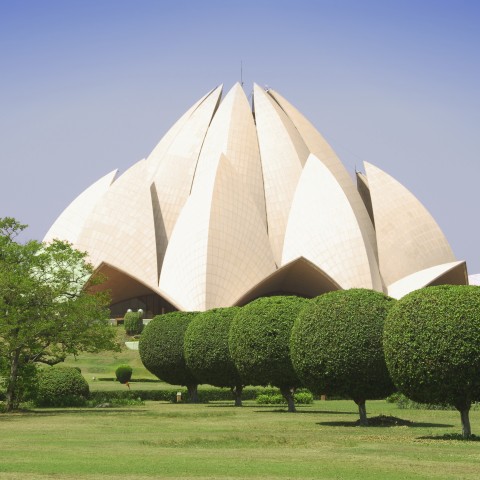
Lotus Temple to Find Peace Within
 Table of Contents
Table of Contents
- Why Study the Different Places to Visit in Delhi?
- Delhi in a Nutshell: Know Before You Go
- Must-See Places for a 1-3 Day Trip
- Highly Recommended Places for a 4-7 Day Trip (or Longer)
- Hindi Survival Phrases for Travelers
- Learning Hindi Can Be So Much Fun!
1. Why Study the Different Places to Visit in Delhi?
For starters, reading about the places you plan to visit beforehand is a smart thing to do and helps you better prepare for safe travel. It allows you to understand and become familiar with the local culture, weather, food, and language so that there are fewer surprises during your stay.
And let’s be honest: Delhi is huge. It would be impossible to see and do everything this city has to offer in just a week, let alone two or three days. The capital is known for its vast array of spicy Indian foods, fancy hotels, historical buildings, shopping centers, and amazing architecture. Because there are so many exciting experiences waiting for you, it can be a real headache choosing which places to visit and which ones to skip.
Trying to figure everything out on your own will only add to the confusion! In this context, our New Delhi travel guide will save you a hell of a lot of time and energy. After reading this article, you won’t have to sift through an enormous list of tourist spots—the very best places will be right here, each one with a brief description to give you an idea of what to expect.
2. Delhi in a Nutshell: Know Before You Go
Before your visit, how about looking at some amazing facts about the capital of India? In this section, we’ll tell you all about its history, describe what to expect weather-wise, offer travel tips, and more.
Brief History
For as long as four centuries, the Rajputs dominated the entire region of Delhi. It was then captured and ruled by the Delhi Sultanate, followed by the Mughal conquest, and later the British. In the late 1940s, Delhi was finally free to be ruled by its people.
Such a long era of foreign domination shows clearly in the food preferences and architecture of Delhi, and this is why so many Mughal buildings top the list of Delhi travel spots.

How to Plan a 2-3 Day Trip
Territory
With more than thirty million people living here, Delhi is a heavily populated union territory located in the northern part of India. It has been the center of attraction since the Mughals ruled the country. Even today, people from all over the country relocate to Delhi either for better job prospects or to gain a higher education.
In official terms, Delhi is known as the National Capital Territory of Delhi (NCT). New Delhi is a small part of it, functioning as the capital of India. You’ll often hear about Old Delhi, New Delhi, and the national capital regions, such as Noida. Well, they are all parts of NCT.
Weather
The weather in Delhi is mostly extreme. Here’s a breakdown of what to expect:
- The hottest months are May and June.
- The humidity is at its highest from July to September.
- The winter season is at its peak during December and January.
So, the best season to visit New Delhi is somewhere between February and April or from October to mid-December. The weather is most mild during these months.
Languages
Before visiting the capital of India, it would be ideal to learn a few useful Hindi phrases. That said, keep in mind that immigrants from all over the country arrive in Delhi in search of employment. So although Hindi is the main language spoken here, you’ll find that quite a few Haryanvi, Punjabi, and Bhojpuri words have become incorporated into the locals’ language.
Many locals also understand and speak English, so you won’t face any major communication problems while talking with the people here. But knowing common Hindi words and phrases will give you an edge in bargaining while shopping or taking an autorickshaw.
Important Documents
Before making your Delhi travel plans, arrange all of the essential documents you might need. A valid passport and an Indian visa will be required; one can also apply for an e-visa for tourism purposes. It’s also a good idea to carry your passport-size photographs with you. For more information, please check out this website.

Buckle Up for Your Visit to New Delhi!
Daily Budget for Traveling in Delhi
INR (Indian Rupee) is the official currency of India. One USD (United States Dollar) is equal to approximately INR 70. Just so you know, the old 500 and 1000 rupee notes have become invalid since their demonetization in 2016. Instead, new 200, 500, and 2000 rupee notes are being used; new 10, 20, and 100 rupee notes have also been introduced. So, you’ll find both old and new notes in circulation.
The daily cost of staying in Delhi hotels, including the eating and traveling expenses, may range somewhere between INR 1000 (approx. $15) to INR 7000 (approx. $100). Everything depends on your preferences. The bottom line is that Delhi has something for every budget.
Budget Tip: If you’re trying to save some money, avoid taking the AC rooms in the months when the weather is pleasant.
Popular Modes of Conveyance
The cheapest and safest public conveyance is the Delhi metro. It covers almost all of Delhi and can take you to all of the important places. For hassle-free traveling, get a metro smart card. It’s a cashless and smart way to avoid long lines at the ticket counter. Just remember that the Delhi metro closes at 11:30 p.m.
Delhi cabs can take you anywhere the metro cannot. They’re a bit expensive but more convenient. An easy way to save some money on cabs is to book one on Uber or Ola.
Another popular option is to take an autorickshaw. However, the prices that autorickshaw drivers charge tend to vary widely. It’s better to bargain and fix a rate before getting in; also make sure that they reset the meter before starting the journey. A road map will help you check that the route followed by the cab and auto drivers is the shortest way to reach your destination.
Keeping safety in mind, please avoid traveling in autorickshaws at night, especially to secluded places. Instead, you should opt for a cab/metro or borrow a friend’s car when it’s late.
Travel Tips
Before we start talking about the best places to visit in New Delhi, here are some worthy travel tips for you.
- It’s a good idea to keep some cash handy.
- Safety is paramount. Tourists should avoid wandering alone at night (even local people follow this rule!). Either keep some company or arrange a personal conveyance if you’re planning to stay out late at night. Female travelers may want to wear something loose-fitting that is less revealing and covers most of the body.
- Walk like you own the place. Yes, your body language plays a huge role in India, especially if you’re a foreigner. Be confident and be sure to use some Hindi words and phrases once in a while. Doing so will save you from extravagant prices and scams.
- When it comes to hygiene, yes, we lack it in many places. So, remember to carry some tissue papers, face wipes, menstrual cups (if you’re a female or traveling with a female partner), small hand wash bottles, and sanitizer at all times.
- Avoid drinking tap water at all costs and opt for packaged water.
- Come rain or shine, having an umbrella really pays off. You can use it when the sunshine is too much to take or when the rain is about to ruin your day! 🙂
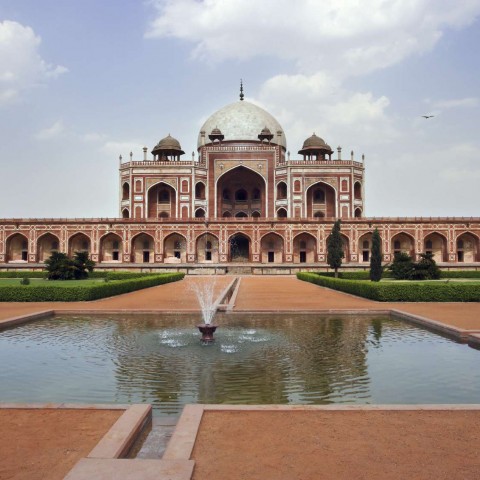
Humayun’s Tomb in Delhi
3. Must-See Places for a 1-3 Day Trip
Wondering what places to visit in New Delhi on a tight schedule? To give you a hand, we’ve listed the most popular tourist spots in Delhi. Let’s take a look.
Red Fort = लाल क़िला (LaaL QiLaa)
The Red Fort, built from 1639 to 1648 by Emperor Shah Jahan, served as the abode of the Mughal dynasty after Delhi replaced Agra as the Mughal capital. The fort has huge historic and political significance, and is considered a living testimony of brilliant Mughal architecture. UNESCO declared it a World Heritage site in 2007.
Every year on August 15—India’s Independence Day—the Indian Prime Minister hoists the flag on the fort’s main gate.
Red Fort has many qualities that visitors just love. While visiting the fort, you’ll get to experience the awe-inspiring architecture and designs of the pavilions. Since it has huge premises, you can lay back or stroll about in the beautiful gardens. In the evening, there’s a special show to entertain visitors.
The fort is surrounded by a local market full of hawkers who sell exotic little pieces of jewelry, traditional clothes, etc. at very economical prices. You’ll also find dhabas (roadside restaurants) that offer a wide variety of traditional Indian foods.
Jama Masjid = जामा मस्जिद (jaamaa maSjiD)
Jama Masjid, fondly called “the mosque of celestial sphere,” was built by Emperor Shah Jahan between 1650 and 1656. It has a huge courtyard that can easily house around 25,000 people at a time. The mosque has four watchtowers that were used for surveillance to avoid intrusion.
If and when you visit the mosque, you’ll be shown two minarets that are 40 meters (about 131 feet) high. You can climb either one to get a view, something most visitors love to do. If you take a stroll outside the mosque, you’ll be greeted with many local restaurants offering Mughal delicacies.
India Gate = इंडिया गेट (iNdiaa gait)
The India Gate is an archway built as a memorial to honor the chivalry of valiant soldiers. This WWI memorial is constructed of sandstone and stands 42 meters (about 138 feet) tall. As a one-of-a-kind location, India Gate attracts visitors from outside of India and locals alike. It’s surrounded by well-manicured lawns that gradually came to be a favorite picnic spot among locals.
If you visit the place in the early morning, you can take a stroll in the serene surroundings of Rajpath near India Gate. But if you’re someone who enjoys hustle and bustle, you might want to visit in the evening. This is when the place is most populated by locals, visitors, hawkers, food lorries, ice-cream stalls, you name it. Not to mention the beautiful lighting and fountains that lend ‘life’ to the area. You can even enjoy a boat ride on the lake!

Best Travel Tips to Keep in Mind
Qutub Minar = क़ुतुब मीनार (quTub miiNaar)
This minaret is another UNESCO World Heritage site and one of the most elegant New Delhi sites to visit. At 72.5 meters (238 feet) heigh, it’s the world’s tallest tower made with bricks—and it has maintained this “tallest brick tower” position for eight hundred years! It has 397 steps and five different stories.
While visiting the minaret, you might want to visit the different mosques, minars, and tombs within it. This place is most recommended for its architectural brilliance. The minaret tapers up from a 47-foot diameter at the base to a 9-foot diameter at the peak.
Akshardham Temple = अक्षरधाम मंदिर (aksaraDHaam maNDir)
Akshardham is a Hindu temple, created by Pramukha Swami Maharaj and officially inaugurated on November 6, 2005. It’s located at the center of the Akshardham complex, and surrounded by a huge campus that signifies the spiritual-cultural legacy of Hindu traditions in India.
You’ll want to visit the temple if you enjoy quietude, greenery, spaciousness, culture, heritage, and spirituality. There are many things to see and do at the Akshardham. For example, you can admire the 11-foot high gold-plated statue of Lord Swaminarayan, to whom the temple is dedicated. At the 85-foot wide and 65-foot tall giant screen theater, you can enjoy Neelkanth Darshan—a 40-minute film on a Yogi. It’s highly recommended for those who want to experience India’s rich heritage, spirituality, and culture.
Lotus Temple = लोटस टेम्पल (LotaS tempaL)
Known in Hindi as Kamal Mandir, or कमल मंदिर (kamaL maNDir), Lotus Temple gets its name from its unique lotus-like structure. It would be no exaggeration to call it an architectural marvel. Unsurprisingly, it has won many architectural awards. It’s a Baha’i house of worship and it welcomes all with no discrimination toward any religion.
The Lotus Temple is dedicated to no specific deity and it has no statue. When you visit the temple, you just sit quietly under its huge dome-like structure on one of the hundreds of chairs. You can experience the peace, serenity, and architecture.
We highly recommend visiting this location so that you can experience how the Baha’i religion, which is relatively new, puts emphasis on oneness and strives to help people drop all prejudices that might originate from race, nationality, and gender.
Connaught Place = कनॉट प्लेस (kaNaut pLeS)
Connaught Place, one of the most happening destinations in Delhi today, was once the location of British HQ. It has two circles: the inner circle is called Rajeev Chowk and the outer one is Indira Chowk.
Today, Connaught Place (fondly known as CP by Delhites) is Delhi’s business and finance hub. That is not to say, however, that it’s full of corporations and offices. Far from that! CP boasts art galleries, vintage cinemas, roadside eateries, upscale restaurants, streetside shops selling shoes and clothes, and showrooms of big brands.
It’s a huge open market that has something for everyone, making it difficult for us to recommend one “best thing to do” here. Whoever you are, you’ll find something to enjoy!

Staying Safe in a Foreign Land
Janpath = जनपथ (jaNapaTH)
Located near CP, Janpath is the place to go if you love streetside shopping. Janpath is a Hindi word that can be translated as “people’s path,” though the area was once known as Queensway. Janpath is one of the most well-known Delhi markets among both locals and foreigners. It’s flanked by shops on both sides, a long stream of shops one after another.
Most of these shops are boutiques that sell hard-to-find items you won’t come across in big multi-chain stores. It’s an ideal place for budget travelers and those who like buying hand-crafted items or garments. After so much shopping and walking around, you’re likely to start feeling some hunger pangs…
No need to worry, though! Janpath has got you covered with its many eateries that serve Indian-style fast food.
This is the best place to go if you want to shop your heart out without breaking the bank.
Chandni Chowk = चांदनी चौक (caanDNii couk)
Located near the Old Delhi Railway Station, Chandni Chowk is one of the oldest and busiest markets. Situated near the Red Fort and the Jama Masjid, it was designed by Emperor Shah Jahan’s daughter Jahanara. It’s a half-moon-shaped square.
The market has something for everyone: traditional food, Indian perfumes, silver jewelry, spices, nuts, and the list goes on. If you’re interested in experiencing the local flavors, we highly recommend visiting the Paranthe Wali Gali located here; it’s the perfect place to try traditional Indian Parathas. Also, because Chandni Chowk is Asia’s biggest wholesale spice market, you might want to grab some high-quality, low-cost spices.
4. Highly Recommended Places for a 4-7 Day Trip (or Longer)
Are you able to stay a little longer? Great! This will allow you to see and experience so many more amazing locations. Here are a few extra places you must visit in New Delhi if you have the time.
Hauz Khas Village = हौज़ ख़ास विलेज (hauz khaaS viLej)
Are you looking for some of the best places to visit with your girlfriend or boyfriend in Delhi? Well, Hauz Khas is just the place to spark the joy and romance between you two! This south Delhi area flaunts the old remains from Khilji’s time, taking you back to the old Mughal period. Apart from the romantic gardens and parks, there is Hauz Khas Fort, Deer Park, a lake, and so much more. It’s an ideal location to spend an entire day with your loved one!
Rashtrapati Bhavan = राष्ट्रपति भवन (raastrapaTi bhavaN)
Every country has an official residence that houses its head of government. The residence of the Indian President is known as Rashtrapati Bhavan. It attracts a lot of travelers because of its architecture and the lush, green gardens loaded with colorful and fragrant flowers. If you’re visiting in the month of February, don’t forget to take a trip through the Mughal Gardens and enjoy the beautiful blooming flowers of the spring. The gardens are only open to the public from early February to mid-March.
Karol Bagh = करोल बाग़ (karoL baag)
Are you a shopper at heart? Then you’d love the Karol Bagh market. It’s cheap, it’s vast, and it’s versatile. You can find everything here, from household items to clothing, electronics, and lots of food (so that hunger doesn’t come between you and shopping!).
You’ll enjoy your time spent here even more if you’re good at bargaining. If you can do that, don’t be surprised if you can get that item at half-price!
Lajpat Nagar = लाजपत नगर (LaajapaT Nagar)
This is another shopping spot with huge malls and big-brand showrooms throughout the entire market. Once you enter the area, it’s like getting inside a shopping heaven. You have so many options to choose from, and all at amazing prices if you can pull off that bargaining trick! You can also stroll around with your family or spouse and just enjoy the rush and spicy street foods.
Sarojini Nagar = सरोजिनी नगर (SarojiNi Nagar)
One of the largest markets in Delhi, Sarojini Nagar is mainly famous for offering stylish clothes at unbelievable prices. This is the go-to place for many students, bachelors, and people on a tight budget.
Ice Lounge = आइस लाउन्ज (aaiS Laaunj)
This is the best place to visit in Delhi in summer. Everything here, including the sculpture, is made of ice. Chill out with your friends or loved ones here, and enjoy the refreshing coolness!
Adventure Island = एडवेंचर आइलैंड (aidveNcar aaiLaind)
This is a great amusement park in Delhi, attracting adventure-lovers of every age. It’s especially popular among those who wish to have fun with their families. The pools, water slides, shopping areas, and delicious food make it one of the must-visit places on your New Delhi travel plan!
5. Hindi Survival Phrases for Travelers
It’s time to quickly review the most useful Hindi travel phrases for your visit to New Delhi. These phrases will come in handy whether you’re shopping, bargaining, taking public transportation, or asking for directions. Memorizing and practicing these short Hindi sentences will go a long way!
1. हेलो (heLo) / नमस्ते (NamaSTe)!
“Hello!”2. शुक्रिया (sukriyaa) / धन्यवाद (DHaNyavaaD)!
“Thank you!”3. चलते हैं। (caLaTe hain.)
“Okay, see you later.”4. माफ़ कीजिए। (maaf kiijiye.)
“I am sorry.” / “Excuse me.”5. बहुत अच्छा! (bahuT acchaa!)
“Great!” / “Okay.”6. ठीक है। (thiik hai.)
“Okay.” / “Alright.”7. ____ जाना है। (__ jaaNaa hai.)
In the blank, put the name of the place you want to go. For example:- कनॉट प्लेस जाना है। (kaNaut pLeS jaaNaa hai.) – “I have to go to Connaught Place.”
- पुरानी दिल्ली जाना है। (puraaNii DiLLii jaaNaa hai.) – “Take me to Old Delhi.”
8. _____ कितनी दूर है? (__ kiTaNii Duur hai?)
This question is used to ask how far away a certain place is; simply put the name of the place in the blank. For example:- कनॉट प्लेस कितनी दूर है? (kaNaut pLeS kiTaNii Duur hai?) – “How far is Connaught Place?”
- पुरानी दिल्ली कितनी दूर है? (puraaNii DiLLii kiTaNii Duur hai?) – “How far is Old Delhi?”
9. वॉशरुम कहाँ / किधर है? (vausaruum kahaan / kiDHar hai?)
“Where is the washroom?”10. ____ किधर पड़ेगा? (__ kiDHar padegaa?)
“Where’s _____?”Just fill in the blank with the name of the place you’re asking about.
11. मुझे ये चाहिए। (mujhe ye caahiye.)
“I want this.”12. ___ है? (__ hai?)
“Do you have ____?”This question is useful when shopping; fill in the blank with the item you’re inquiring about.
13. कितना हुआ? (kiTaNaa huaa?)
“How much?”This is a common phrase to use when paying for something, like a restaurant bill or autorickshaw ride.
14. इसका दाम कितना है? (iSakaa Daam kiTaNaa hai?)
“What’s the price?”You can use this phrase to ask for the price of an item you’re interested in, especially if you want to bargain a little.
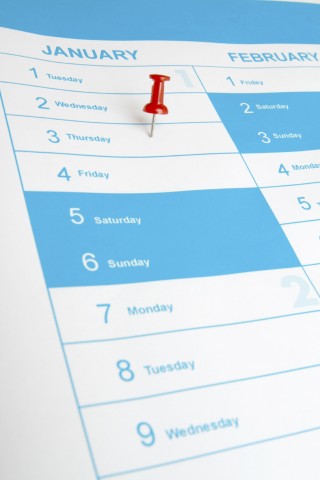
Best Months to Be in India
15. इसका दाम बहुत ज़्यादा है। (iSakaa Daam bahuT zyaaDaa hai.)
“This is too expensive!”This is another useful bargaining phrase.
16. मुझे समझ में नहीं आया। ज़रा फिर से बताइये। (mujhe Samajh men Nahiin aayaa. zaraa phir Se baTaaiye.)
“I can’t understand you. Could you please explain it again?”17. क्या आप अंग्रेज़ी समझते / समझती हैं? (kyaa aap angrezii SamajhaTe / SamajhaTii hain?)
“Do you understand English?”18. मेरी मदद कीजिए! (merii maDaD kiijiye!)
“Please, help me!”
Learn the Most Helpful Hindi Phrases with Us
6. Learning Hindi Can Be So Much Fun!
Which of these New Delhi locations are you most excited to visit, and why? Let us know in the comments!
Of course, before you leave for your dream destination, you’ll want to know a few key phrases and basic vocabulary. The phrases we listed above are a great place to start, but the more Hindi you know, the smoother and more fulfilling your trip will be!
Here at HindiPod101.com, we understand how difficult and tiring language learning can be. That’s why we always aim to teach our students Hindi in the most fun and interesting way possible.
With our high-quality lesson materials and useful study tools (such as our Grammar Bank and online dictionary), even beginners feel at ease and are more inclined to pursue their Hindi learning goals. Say goodbye to boredom and experience the new era of Hindi studies with our user-friendly app.
We’re wishing you happy Hindi learning and safe future travels!

Decoding the Indian ‘Hinglish’ Words with a Local Touch!

Who would have imagined that English words like “bundle,” “time-pass,” or “boss,” could mean anything other than what they’re supposed to mean?
In India, Hinglish—or the tendency of Hindi speakers to overuse English words while speaking—has become a thing! And it doesn’t stop there. These brain teasers often give non-natives quite a hard time, because the actual meaning of English words in Hindi is far different from the original definition.
Yeah, welcome to “Hindia“!

English Loanwords
 Table of Contents
Table of Contents
- Why Learn English Words Used in Hindi?
- The Birth of Hinglish
- Hinglish Words & Example Sentences
- Loanwords vs. Hinglish Words
- Famous Names Pronounced in Hindi
- English Words Derived From Hindi
- Become a Fluent Hindi Speaker with HindiPod101.com
1. Why Learn English Words Used in Hindi?
While Hinglish words may sound familiar to you as an English speaker, it’s important to remember that these words often have different meanings or nuances from what you’re used to.
If you don’t know the exact meaning of a Hinglish word, you’re likely to misunderstand the whole context of a conversation. And sometimes, even the seemingly simple English phrases spoken by the natives can be quite confusing for beginners.
In today’s lesson, we’ll look at the most common English words in Hindi, their literal meaning, and their actual meaning in the Indian context. But first, here’s a list of ways in which learning these popular hybrid words will benefit you!
- They will ensure you never miss a pun.
- They will make it easier to speak with natives.
- You will be able to understand the hidden affection or taunt in a word.
- You will feel like part of the group.
- You won’t accidentally offend or feel offended for the wrong reasons.
- They will eventually help you sound like a native! 😉
2. The Birth of Hinglish
So how exactly did English words become so prominent in Hindi?
In a broad sense, Hinglish history can be traced back to the time when India was the “golden bird” (SoNe kii cidiyaa) that everybody wanted to conquer. Over the centuries, many foreign countries have attacked and ruled the subcontinent. These countries include the British, the Portuguese, the French, the Mughals, and several others.
As a result, each civilization left an impression on the Indian culture. Indian society became a sponge, absorbing all of the elements impacting it and infusing them into its own culture. These influences are visible even today in what is presently known as the Indian Republic, be it in the way people dress, the way they eat, or the way they speak. Hinglish just happens to be the latest ‘thing’ on this list.
The name itself suggests that Hinglish is a combination of the Hindi and English languages. The younger generations in India have witnessed—and reasonably accounted for—the popularity of Hinglish in online chats, texting slang, and day-to-day conversations. However, the older generation has also (voluntarily) embraced its charm.

English Words with a Local Touch
3. Hinglish Words & Example Sentences
In this section, we’ll share with you several Hinglish examples so you can get a better idea of how Indians use English words in Hindi.
| 1. “Filmi” – फ़िल्मी (fiLmii) | |
| Hinglish Meaning | A person who is overreacting / A dramatic incidence |
| Actual English Meaning | Derived from the word “film” |
| In a Sentence | दुल्हन की विदाई के समय बिल्कुल फ़िल्मी माहौल हो गया था। DuLhaN kii viDaaii ke Samay biLkuL fiLmii maahauL ho gayaa THaa. “As the bride was leaving, the whole atmosphere became dramatic.” |
| 2. “Time-pass” – टाइम-पास (taaim-paaS) | |
| Hinglish Meaning | Not taking something seriously / Something that doesn’t interest you much |
| Actual English Meaning | “Passing the time” / “Hobby” |
| In a Sentence | आज वाली मूवी बस टाइम-पास थी। aaj vaaLii muuvii baS taaim-paaS THii. “Today’s movie was just okay.” |
| 3. “Number” – नंबर (Nambar) | |
| Hinglish Meaning | A multipurpose word that can mean “score,” “phone number,” “waiting number,” “chance,” etc. |
| Actual English Meaning | “Numeral” / “Phone number” |
| In a Sentence | अपना नंबर बता! apaNaa Nambar baTaa! “Give me your phone number.” |
| 4. “Bundle” – बंडल (baNdaL) | |
| Hinglish Meaning | A totally useless person you can’t count on |
| Actual English Meaning | A stack of things |
| In a Sentence | पुनीत एकदम बंडल आदमी है। puNiit ekaDam baNdaL aaDamii hai. “Puneet is a useless person.” |
| 5. “Hero” / “Heroine” – हीरो / हीरोइन (hiiro / hiiroiN) | |
| Hinglish Meaning | Can be used to praise or taunt someone (the latter when that person is trying to act smart) |
| Actual English Meaning | The lead actor/actress in a movie / A brave person who performs good deeds |
| In a Sentence | सीमा, तुम तो इस ड्रेस में एकदम हीरोइन लग रही हो! Siimaa, Tum To iS dreS men ekaDam hiiroiN Lag rahii ho. “Seema, you look so gorgeous in this dress.” |
| 6. “Puncture” – पंक्चर (pankcar) | |
| Hinglish Meaning | Mentally or physically exhausted |
| Actual English Meaning | A small hole in a tire or something else that’s inflated |
| In a Sentence | भीड़ और गर्मी से दिमाग़ पंक्चर हो गया। bhiid aur garmii Se Dimaag pankcar ho gayaa. “The heat and the crowd exhausted me completely.” |

Feeling “Punctured?” Oops… “Exhausted!”
| 7. “Junglee” – जंगली (jangaLii) | |
| Hinglish Meaning | Lacking in social manners |
| Actual English Meaning | Derived from the word “jungle” |
| In a Sentence | ये बच्चे तो बिल्कुल जंगली हैं। ye bacce To biLkuL jangaLii hain. “These kids are so mischievous.” |
| 8. “First-class” – फ़र्स्ट-क्लास (farSt-kLaaS) | |
| Hinglish Meaning | “Everything is perfect!” |
| Actual English Meaning | A rank / A division / A railway coach / A high-end airline class |
| In a Sentence | A: तबियत कैसी है? TabiiyaT kaiSii hai? “How are you feeling?” B: एकदम फ़र्स्ट-क्लास! ekaDam farSt-kLaaS! “Perfect!” |
| 9. “Thug-life” – थग-लाइफ़ (THag-Laaif) | |
| Hinglish Meaning | A life somebody is enjoying a lot |
| Actual English Meaning | A slang term for “criminal-life” or “a self-built person” |
| In a Sentence | कमल की तो थग-लाइफ़ चल रही है। kamaL kii To THag-Laaif caL rahii hai. “Kamal is enjoying his carefree life!” |
| 10. “Boss” – बॉस (bauS) | |
| Hinglish Meaning | Buddy / Friend |
| Actual English Meaning | A person’s direct superior in the workplace |
| In a Sentence | क्या हाल है, बॉस! kyaa haaL hai, bauS! “How are you, buddy?” |
| 11. “Solid” – सॉलिड (SauLid) | |
| Hinglish Meaning | Awesome / Perfect |
| Actual English Meaning | Something strong |
| In a Sentence | आज तो तुम एकदम सॉलिड दिख रहे हो। aaj To Tum ekaDam SauLid Dikh rahe ho. “Wow! You look amazing today.” |
| 12. “Lollipop” – लॉलीपॉप (LauLiipaup) | |
| Hinglish Meaning | Something to please someone or calm them down temporarily instead of giving them what they want / False promise |
| Actual English Meaning | A candy |
| In a Sentence | हर चुनाव से पहले नेता लोग जनता को कोई न कोई लॉलीपॉप दे देते हैं। har cuNaav Se pahaLe NeTaa Log jaNTaa ko koii Na koii LauLiipaup De DeTe hain. “Before every election, the political leaders try to woo the public with false promises.” |

“Hello, ‘boss’, how are you doing?”
| 13. “Picture” – पिक्चर (pikcar) | |
| Hinglish Meaning | Movie |
| Actual English Meaning | Photograph |
| In a Sentence | कल हम सब पिक्चर देखने जा रहे हैं। kaL ham Sab pikcar DekhaNe jaa rahe hain. “Tomorrow, we are all going to watch a movie.” |
| 14. “Would-be” – वुड-बी (vud-bii) | |
| Hinglish Meaning | Fiance |
| Actual English Meaning | A generic term used to describe a prospective/aspiring person or relationship |
| In a Sentence | आइये, आपको अपनी वुड-बी से मिलाता हूँ। aaiye, aapako apaNii vud-bii Se miLaaTaa huun. “Come here, meet my fiance.” |
| 15. “Heropanti” – हीरोपंती (hiiropanTii) | |
| Hinglish Meaning | Acting overly smart |
| Actual English Meaning | Derived from the English word “hero” |
| In a Sentence | ज़्यादा हीरोपंती मत दिखाओ। zyaaDaa hiiropanTii maT Dikhaao. “Don’t try to be a smart aleck.” |
| 16. “Pass out” – पास-आउट (paaS-aaut) | |
| Hinglish Meaning | Having graduated from a school/college |
| Actual English Meaning | To faint |
| In a Sentence | तुम किस कॉलेज से पास-आउट हो? Tum kiS kauLej Se paaS-aaut ho. “Which college did you pass from?” |
| 17. “Bheja-fry” – भेजा-फ़्राई (bhejaa-fraaii) | |
| Hinglish Meaning | Bored / Exhausted |
| Actual English Meaning | There’s no such word in English |
| In a Sentence | इतनी गर्मी में भेजा-फ़्राई हो गया। iTaNii garmii men bhejaa-fraaii ho gayaa. “It’s so hot, I’m exhausted!” |
| 18. “Good Name” – गुड-नेम (gud-Nem) | |
| Hinglish Meaning | Used to ask someone’s name in a polite way |
| Actual English Meaning | The actual way to ask is “Name, please?” |
| In a Sentence | आपका गुड-नेम क्या है? aapakaa gud-Nem kyaa hai? “What’s your name?” |
Now that we’ve looked at some unique Hinglish words, it’s time to talk about a similar (but distinct) topic: loanwords.
4. Loanwords vs. Hinglish Words
You may be wondering how loanwords are different from Hinglish words. Well, loanwords are words or phrases taken from a foreign language (English) and adapted by the target language (Hindi) while retaining their original meaning. Contrary to loanwords, Hinglish phrases are those which contain a specific meaning understood only by the local people. A Hinglish word may look like an English one, but its meaning is totally different.
 Learn Hindi with a Twist
Learn Hindi with a Twist
Nowadays, we Indians use countless English words in our daily lives. These words have become such an inseparable part of our language that we often forget we’re using English words at all!
The main reason for using English loanwords in Hindi is that the English word is often much simpler to pronounce than the Hindi word. For example, “train” in Hindi is लौहपथगामिनी (LauhapaTHagaamiNii). Imagine using this long phrase every time you wanted to say “train.” That doesn’t sound too practical, does it?
Some important English words in Hindi include:
- “bus” = बस (baS)
- “train” = ट्रेन (treN)
- “time” = टाइम (taaim)
- “copy” = कॉपी (kaupii)
- “coffee” = कॉफ़ी (kaufii)
- “juice” = जूस (juuS)
- “pen” = पेन (peN)
- “airport” = एयरपोर्ट (eyaraport)
- “bed” = बेड (bed)
- “inverter” = इन्वर्टर (iNvartar)
- “sandwich” = सैंडविच (Sandavic)
- “bread” = ब्रेड (bred)
- “internet” = इंटरनेट (iNtaraNet)
- “form” = फ़ॉर्म (faaurm)
- “phone” = फ़ोन (foN)
- “bathroom” = बाथरूम (baaTHaruum)
- “cooler” = कूलर (kuuLar)
- “TV” = टीवी (tiivii)
- “dining table” = डाइनिंग टेबल (daaiNing tebaL)
- “fridge” = फ़्रिज (frij)
- “handwriting” = हैंडराइटिंग (haindaraaiting)
- “station” = स्टेशन (StesaN)
Example Sentences:
- बस कितने बजे आएगी? (baS kiTaNe baje aayegii?)
“At what time will the bus arrive?”
- बाथरूम दाहिनी ओर है। (baaTHaruum DaahiNi or hai.)
“The bathroom is on the right side.”
- हमारा टीवी दो दिन से ख़राब है। (hamaaraa tiivii Do DiN Se kharaab hai.)
“Our TV has not been working for two days.”
- स्टेशन यहाँ से चार किलोमीटर दूर है। (StesaN yahaan Se caar kiLomiitar Duur hai.)
“The station is four kilometers away from here.”
- जूस फ़्रिज में रख दो। (juuS frij men rakh Do.)
“Keep the juice in the fridge.”
5. Famous Names Pronounced in Hindi
Pronunciation is the biggest difference between how English speakers and Hindi speakers say words. There are distinct characteristics in the way Indian people speak, especially when it comes to foreign brands, celebrity names, movie names, etc.

Pronouncing Famous Names in Hindi!
To get a better idea of the correct pronunciation of English words in Hindi, take a look at this list of famous celebrity, movie, and brand names and their Hindi equivalents.
- “Tom Cruise” = टॉम क्रूज़ (taum kruuz)
- “Beyonce” = बियॉन्से (biyaunSe)
- “Backstreet Boys” = बैकस्ट्रीट ब्वॉयज़ (baikaStriit boyz)
- “Arnold Schwarzenegger” = अर्नोल्ड श्वार्ज़नेगर (arNauLd svaarzaNegar)
- “YouTube” = यूट्यूब (yuutyuub)
- “Facebook” = फ़ेसबुक (feSabuuk)
- “LinkedIn” = लिंक्डइन (LinkdiN)
- “Titanic” = टाइटैनिक (taaitaiNik)
- “Mission Impossible” = मिशन इम्पॉसिबल (misaN impauSibaL)
- “Interstellar” = इंटरस्टेलर (intaraSteLar)
- “The Godfather” = द गॉडफ़ादर (Da gaudafaaDar)
- “Inception” = इंसेप्शन (iNSepsaN)
- “McDonald’s Burger” = मैक डॉनल्ड्स बर्गर (maik dauNaLdS bargar)
- “Nivea” = निविया (Niviyaa)
- “L’oreal” = लॉरिअल (LauriyaL)
6. English Words Derived From Hindi
You’re now familiar with the most common English words in Hindi—but it doesn’t end there! Did you know that there are several English words inspired by Hindi, too?

Waiting for the “bus”?
Here are some popular English words taken from the Hindi language:
- “Yoga” = योग (yog)
- “Mantra” = मंत्र (manTr)
- “Guru” = गुरु (guru)
- “Avatar” = अवतार (avaTaar)
- “Loot” = लूट (Luut)
- “Nirvana” = निर्वाण (Nirvaan)
- “Coolie” = कुली (kuLii)
- “Bungalow” = बंगला (bangLaa)
- “Chai” = चाय (caay)
7. Become a Fluent Hindi Speaker with HindiPod101.com
If you have any native Indian friends, you may have noticed them using a lot of Hinglish and English loanwords. Which words or phrases have you heard most frequently? Share them with us in the comments below. We’d also like to encourage intermediate learners to try making sentences with some of the words we’ve covered.
Did you know that we offer the best online Hindi language learning materials, including our comprehensive lesson on Hindi Pronunciation? If you’re ever uncertain about a word’s meaning, feel free to use our online Hindi-English dictionary or browse through our vast collection of vocabulary lists.
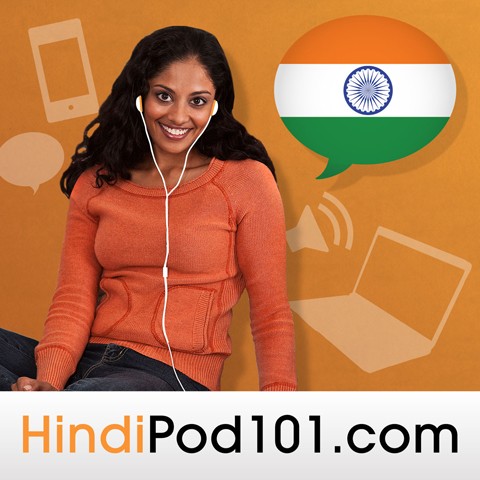
Come and learn with us. 🙂
Once you sign up for a Premium account, you’ll gain access to customized learning pathways specially designed for your needs, starting with the Hindi Basics. In order to learn 24/7, download our mobile app and start studying anywhere, anytime.
Happy learning, and have fun practicing your Hinglish!

A Brief Indian Culture Overview

Indian culture is a melting pot of several languages, countless dialects, and a multitude of beliefs and ways of living. Geographically speaking, the Hindi-speaking belt consists of North Indian states including Uttar Pradesh, Bihar, Gujarat, and Rajasthan.
In this lesson, we’ll take you straight to the heart of these Hindi-speaking regions. We’ll discuss the most important festivals, religious beliefs, popular foods, prevalent family structures, and much more. You’ll soon see that India has come a long way from its extremely conservative past, and is today more experimental and open-minded.
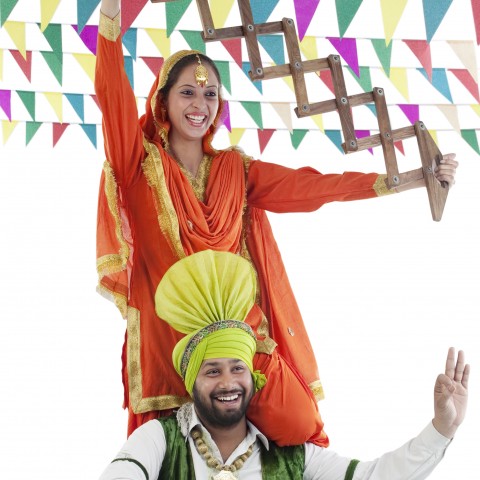
Exploring Indian Culture
If you look at the present Indian society, you’ll find a blend of both old-fashioned and modern ideas. The truth is, no society or country is perfect and the same holds true for India. This guide is a sincere effort to explore the different shades and faces of Indian culture in the Hindi Belt (i.e. Uttar Pradesh). So, let’s begin! 🙂
 Table of Contents
Table of Contents
- Social Values and Beliefs
- Religions and the Caste System
- Shattering the Gender Stereotypes
- Family, Work, and Lifestyle
- Art and Architecture
- Listen to Your Taste Buds
- Traditional Holidays and Festivals
- Talk Like a Native With HindiPod101.com
1. Social Values and Beliefs
Can you imagine separating milk from water? Then you have a good image of how impossible it is to separate the Hindi-Urdu blend of our lingua franca, the Hindustani language. As such, it should come as no surprise that the Hindi culture is not exclusive to Hindus. In fact, some of these social values apply to Muslims, Punjabis, and Sindhis, although their rituals and ways of expression may differ.
In Indian culture, values and beliefs are markedly different between the older and younger generations. This has resulted in a wide generation gap in Indian families, with the older generation being more conservative and the younger generation becoming quite forward. This contrast can be seen in Indian marriage culture, where both arranged and love-based marriages are popular. However, orthodox families strictly opt for arranged marriages.

Changing Social Values
The older generation also believes in values like togetherness, keeping the whole family under one roof, and prioritizing relationships over success and fame. The younger generation, on the other hand, yearns for more freedom and seeks to find a life purpose.
Indians are quite social. They love to talk and be friendly toward each other. It’s common for two strangers to happen upon each other while traveling and start talking like they’ve known each other from Adam. Asking about family or personal life doesn’t usually offend people.
2. Religions and the Caste System
“Unity in Diversity.” This is how we love to portray India!
One of the most defining characteristics of Indian culture is its diverse range of religions. The most prominent are Hinduism, Islam, and Sikhism, whereas Christian, Buddhist, Jain, and Sindhi religions are comparatively less popular.
For Hindus, going to temples is a pretty common part of their routine. They may visit the temple every day or on special occasions such as birthdays, marriages, or before a job interview.
People in India are quite religious, but that’s not to say there are no atheists or people who don’t identify with a specific religion.
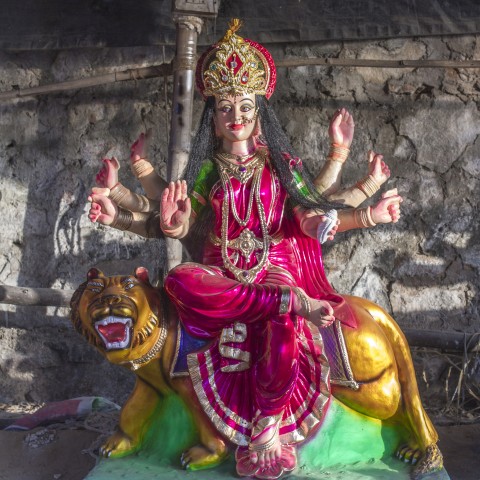
Durga: the Goddess of Hindus
Despite our country’s religious diversity, India does have its share of flaws. In Indian culture, caste systems are alive and well—and its roots go deeper than one can imagine. The Hindu religion itself is divided into many castes and people put great importance on that when considering marriages, helping someone get a job, and many other aspects of daily life.
In Hindu, Brahmins hold the highest position in the religious hierarchy. They are followed by Kshatriyas, Vaishyas, and Shudras. There are also Scheduled Castes and Scheduled Tribes, which are the most vulnerable segment of our society, and thus, protected by many Indian laws. Despite all the claims and efforts, Indian society is still struggling with this system of untouchability.
At the same time, we are emotionally driven. This is not always a good thing, because it affects the political preferences of the common people. The political parties leave no stone unturned to exploit this weak nerve of the general public, especially when it comes to the different religious beliefs.
In reality, both Hindus and Muslims love to live in harmony and support each other in times of crisis. There are so many instances when these two groups of people have shown huge solidarity in the midst of political distress.
3. Shattering the Gender Stereotypes
People are working on gender equality, but there’s a long way to go. In Indian culture, gender roles still play a large role and this disparity shows in almost every aspect of life: upbringing, the male-female child ratio, education, and the freedom to choose one’s partners and professions. Workplaces also suffer from gender inequality when it comes to their pay scales.
While males have traditionally enjoyed the freedom to choose any field of work, females have been—and still are—seen as better-suited for teaching or medical jobs. Nonetheless, this scenario has changed a lot and both men and women are breaking the gender stereotypes.

Achieving Gender Equality: The New Norm of India
Parents are more supportive than ever when it comes to their daughters’ dream jobs. Girls and women are exploring freedom in all aspects of life, be it their jobs, love life, or the decision to remain single. However, intercaste marriages—while slowly gaining acceptance—are no child’s play. Honor killing is still a huge blot on our faces.
In times past, household chores were solely the responsibility of women, whether they had a job or not. Today, husbands, brothers, and fathers are sharing the load at home and changing the definition of typical Indian families.
The latest approval of LGBTQ rights by the Indian Supreme Court is a grand victory for people who stand for equality and believe in the existence of true love. It just shows how much the Indian society has grown and learned to transform itself for the better!
4. Family, Work, and Lifestyle
In Indian culture, marriage is considered a sacred bond between husband and wife. And as you probably know, Indian (Hindu) weddings can be incredibly lavish! The ceremony is full of music, food, and melodrama. Alcohol is rarely served, and when it is, getting drunk is seen as a sign of poor character.
While married Hindu men may flaunt their engagement rings, women are often seen wearing a red bindi, vermillion, bangles, and saree as their traditional attire in the initial days after their marriage. In families that are more open-minded, a married female may wear a salwar suit or Western clothing.
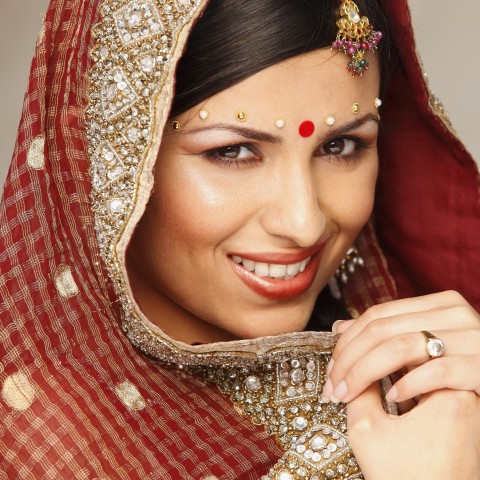
The Iconic Indian Look!
Couples are not shy in public spaces, but they’re not as expressive as those in Western countries. For example, they are comfortable holding hands but kissing and hugging in front of others is almost unheard of. It may come as a shock to you, but there is unspoken pressure on the younger generation to settle professionally and get married by their late 20s.
We have both nuclear and joint families. It’s common to see Indian couples living with their parents (usually the husband’s parents), but nowadays more and more couples are living separately from their parents. They may live in the same town or move to a different part of the country in search of high-paying jobs.
People are open to both traditional jobs and running their own businesses. However, many people are highly inclined to find government jobs, which offer more social and financial security. Those who want to earn more and are open to taking risks would naturally dive into private-sector jobs.
Chewing tobacco, smoking, and drinking alcohol are rather common in states like Uttar Pradesh and Bihar. However, it’s strictly looked down upon and people are expected to do these things privately. To be honest, these habits are widely seen in the lower classes of society. The irony is that when the same things are done by the upper-class people, it’s called “being cool and classy.”
5. Art and Architecture
For the general public, the entertainment industry largely consists of Bollywood movies and Hindi music. Bollywood produces the highest number of movies in the world every year. Those who are more sophisticated love listening to ghazals and classical music. The unforgettable Umrao Jaan, Mirza Ghalib, and Begum Akhtar are all from Uttar Pradesh.
Kathak is the classical dance form of Uttar Pradesh and is quite popular. There are so many youngsters who learn Kathak and vocals, and go on to make careers with these skills. The dance forms vary from one state to another.
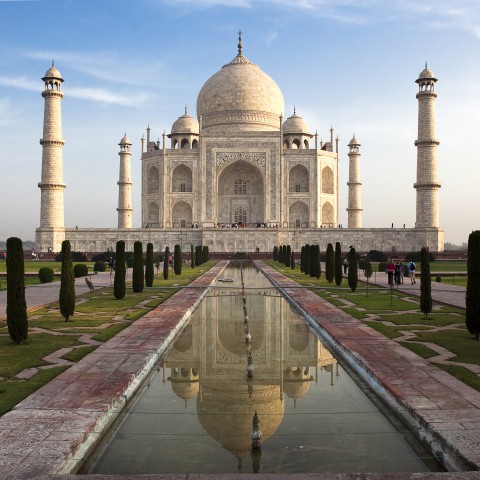
Seven Wonders of the World: The Taj Mahal
When it comes to literature, Urdu and Hindi are two sides of one coin. That ‘coin’ is Hindustani, a beautiful amalgamation like that of milk and honey. This heavenly bond to the Urdu language is not limited to Muslims. So many people have fallen in love with this written language and read Shayari, nazm, revolutionary texts on social evils, as well as the classic literary works of Premchand, Mannu Bhandari, Mirza Ghalib, and Rabindranath Tagore.
Talking specifically about Uttar Pradesh, the hub of the Hindi language, there are various local handicrafts that have long gained worldwide appeal. The embroidery work on sarees and salwar suits is enormously famous. This art form is from Lucknow and is locally known as “chikankari.” In addition, we have the heavy, gorgeous Banarasi sarees with broad borders woven with real gold and silver wires. This embroidery form is known as Zardozi.
Some of the most famous examples of Indian architecture are the Mughal buildings in Lucknow, as well as numerous forts built in some cities of Uttar Pradesh. For instance, we have Bada Imambara and Chhota Imambara in Lucknow. And who hasn’t heard of the Taj Mahal, Agra, one of the Seven Wonders of the World?
Many foreigners and tourists have Mathura and Vrindavan, the birthplace of Lord Krishna, on their bucket list. Ayodhya, the birthplace and kingdom of Lord Ram, is also in Uttar Pradesh. Some of the other famous places like Sarnath (Varanasi), Sangam and Kumbh Mela (Allahabad), Jhansi Fort of Rani Laxmibai (Jhansi), and Agra Fort are also worth visiting!
For the adventurous soul in you, there is also:
- India’s oldest national park, the Jim Corbett National Park
- River rafting in Rishikesh
- The hot and happening waterfalls in Mirzapur
6. Listen to Your Taste Buds
The Indian food culture is quite interesting. It’s versatile with so many different kinds of delicacies. The staple foods in the Hindi-speaking belt are wheat and rice. Chapatis made of wheat flour and rice are usually served with dal (pulses), stir-fried vegetables, gravy-curry, curd, salad, and some sweets. This is famously known as the “Thali system.”

Spicy Indian Food
Uttar Pradesh has introduced many lip-smacking snacks and meals to the entire country. The guava from Allahabad is famous all over India. You can find countless mini stalls and cabin-like shops with huge crowds waiting for chaat and golgappa, a spicy Indian street food. North Indian cuisine, especially that of Uttar Pradesh, is heavily influenced by Mughal flavors. Dishes like biryani, kebabs, naan, rumali roti, and kulfi feature a blend of Indian, Persian, and Iranian flavors.
While Punjab is known for its makke ki roti and sarson ka saag, Rajasthan and Bihar serve the best litti chokha in the world. Gujarati dishes have won many hearts around the globe with their sweet and tangy flavors. Some of the most popular Gujarati items are dhokla, khandvi, and khakra.
7. Traditional Holidays and Festivals
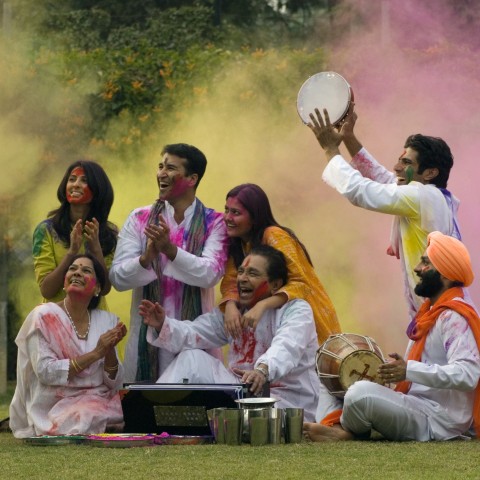
Holi: The Festival of Colors
There are three Indian national holidays: Independence Day (August 15), Republic Day (January 26), and Gandhi Jayanti (October 2). Apart from these, people in the Hindi Belt celebrate hundreds of other festivals, small and large. The prominent ones are:
- Holi (The Festival of Colors)
- Diwali (The Festival of Lights)
- Raksha Bandhan
- Dussehra
These are mainly Hindu festivals but are enjoyed by folks of every religion.
Eid, Bakrid, and Moharram are the prominent festivals for Muslims. Sikhs honor their Guru Sahib by celebrating Gurunanak Jayanti.
8. Talk Like a Native With HindiPod101.com
Indian culture is wonderful, isn’t it? By now, you should be much more familiar with the different cultural aspects of India’s Hindi-speaking regions.
If you’re planning to visit soon, what Indian attire would you try and which street food is on the top of your list? Oh, and which Indian festivals would you love to take part in? We look forward to hearing from you in the comments!

Welcome to the HindiPod101.com Family!
We welcome you to explore our vocabulary lists and online dictionary as you get ready to start (or continue!) your Hindi language learning journey. To learn even more about any of the topics we’ve covered here, don’t forget to create your free lifetime account on the HindiPod101.com homepage. Once you’ve done that, download our mobile app and you’re good to go.
Happy learning!













